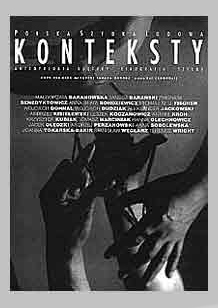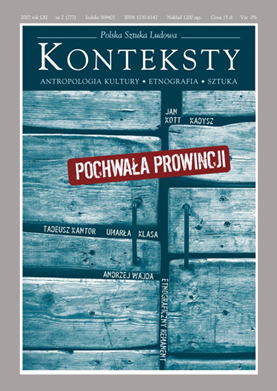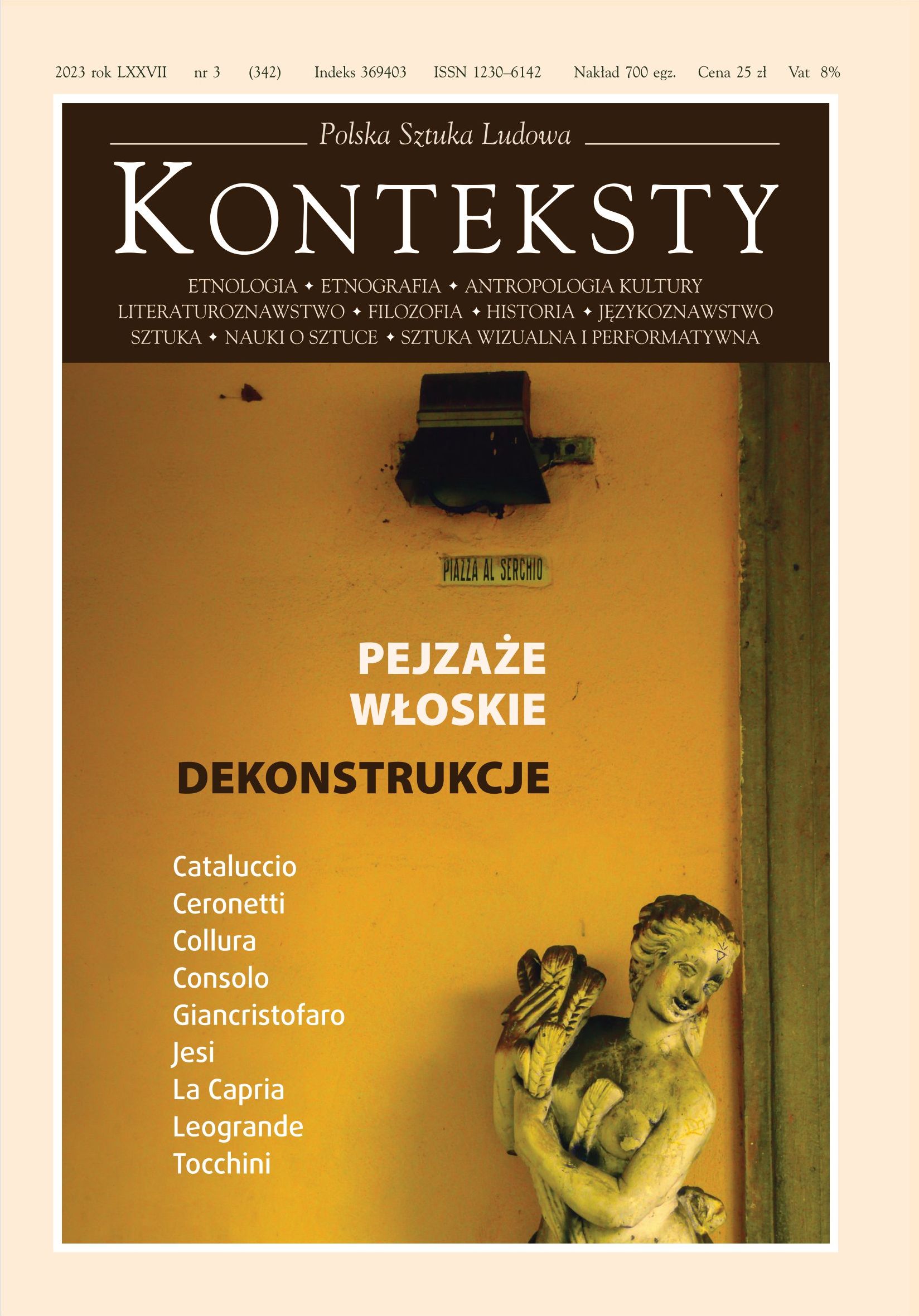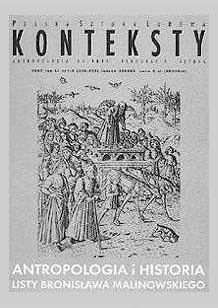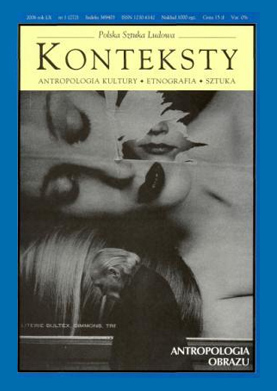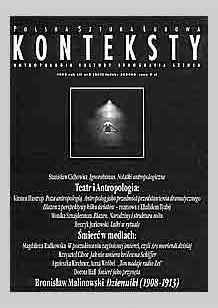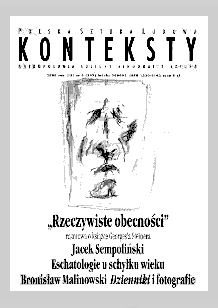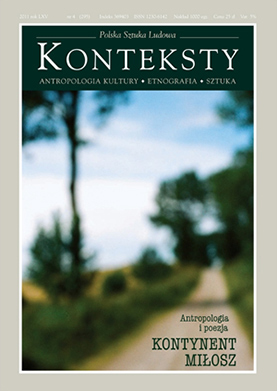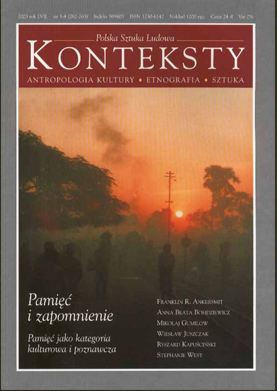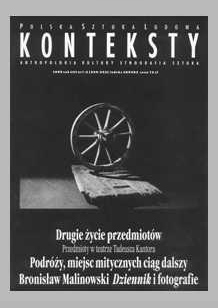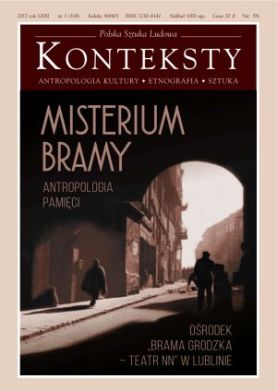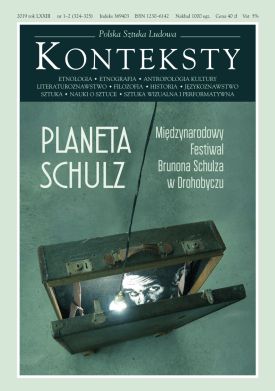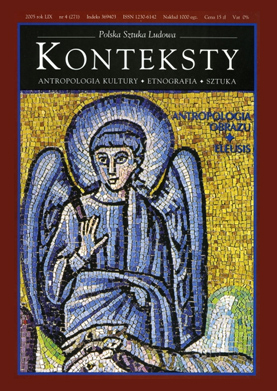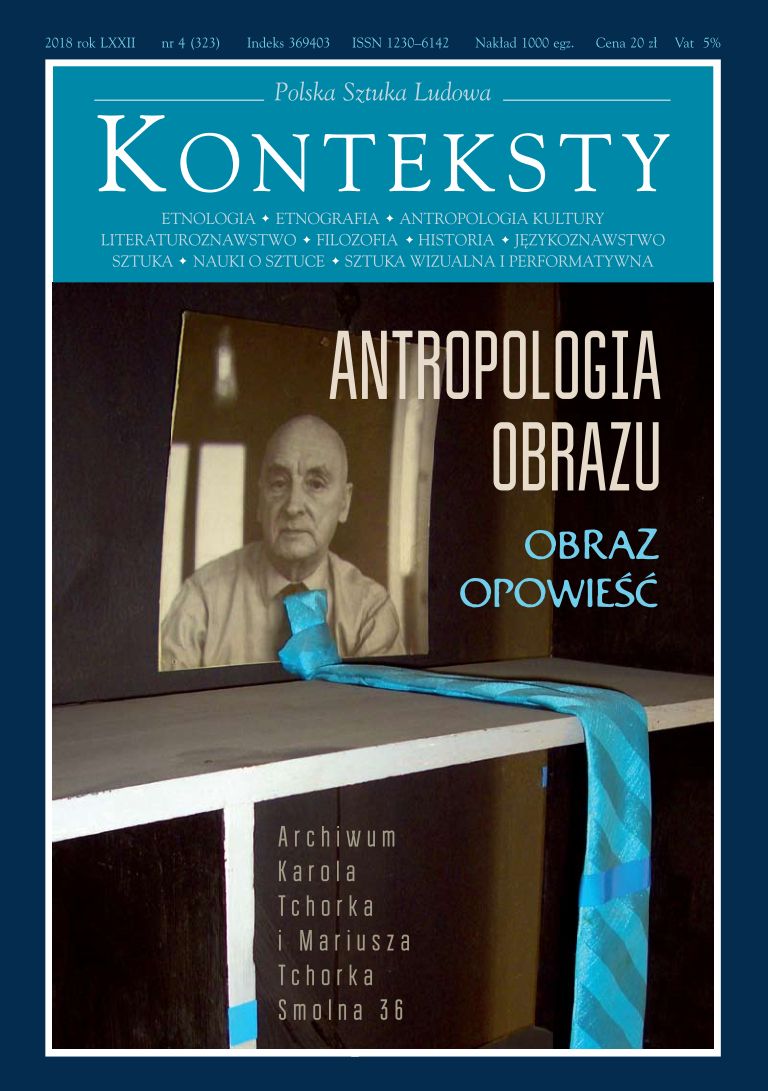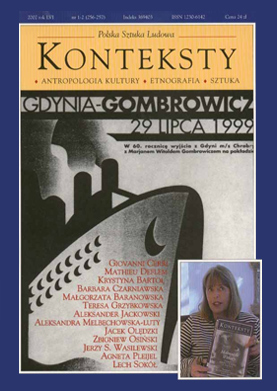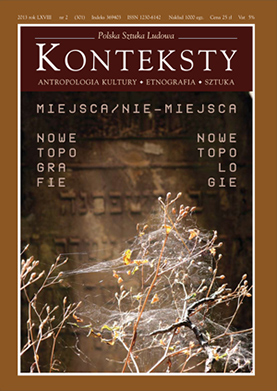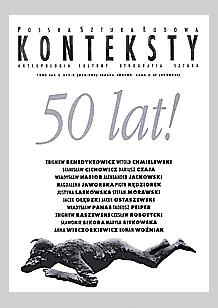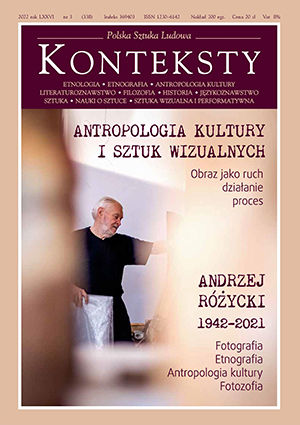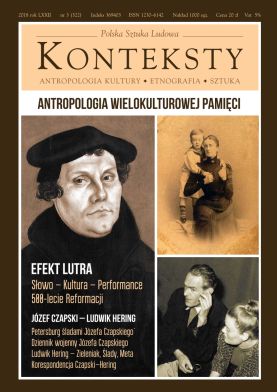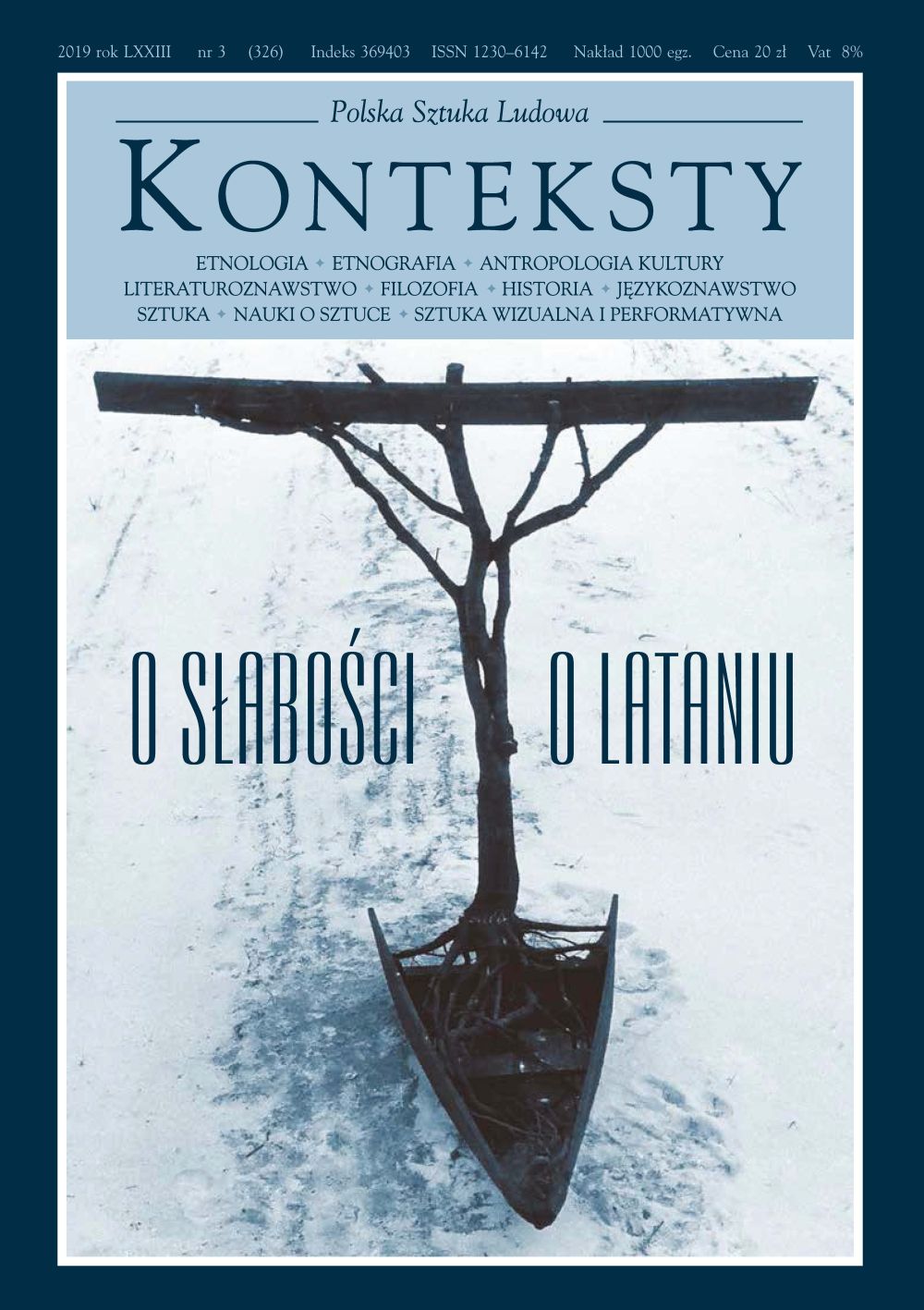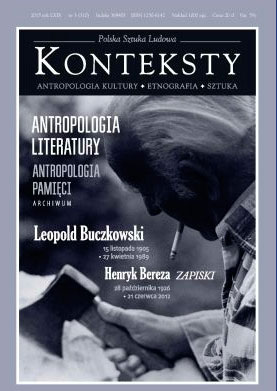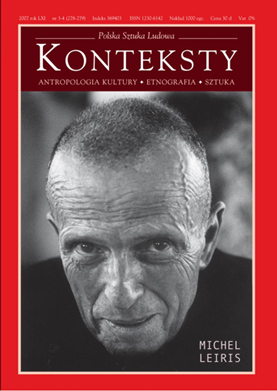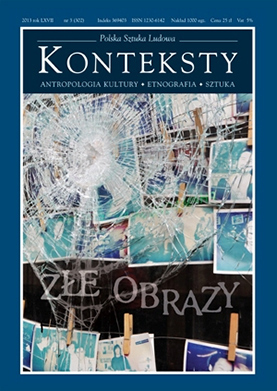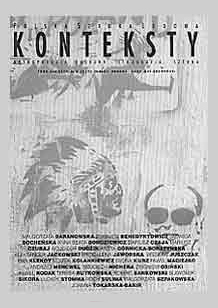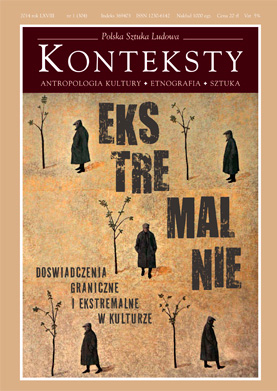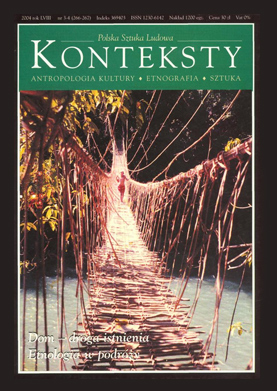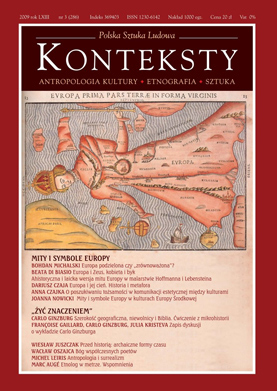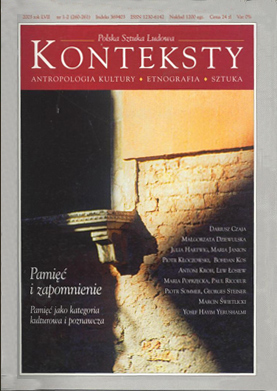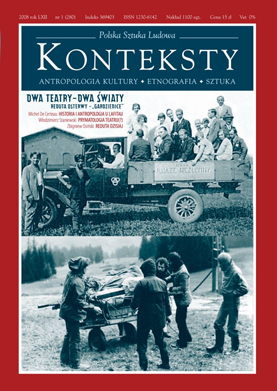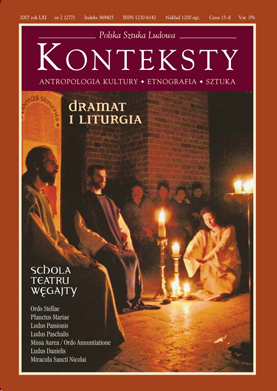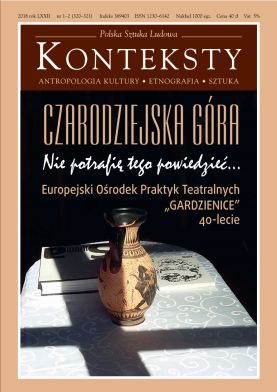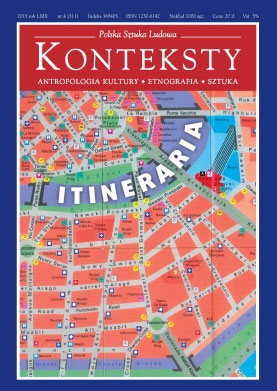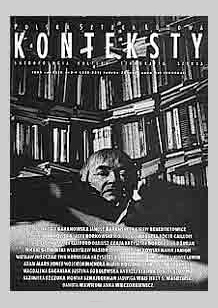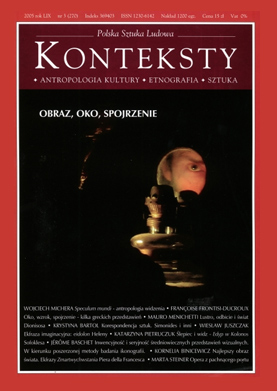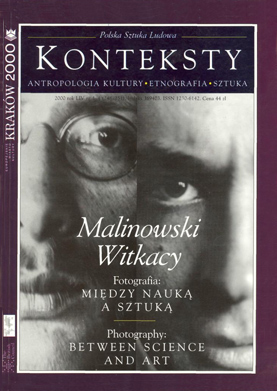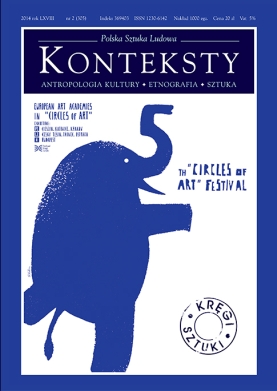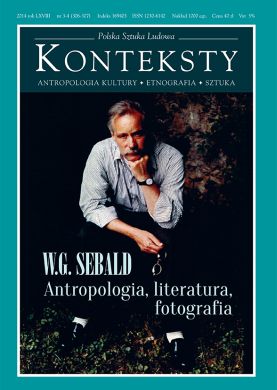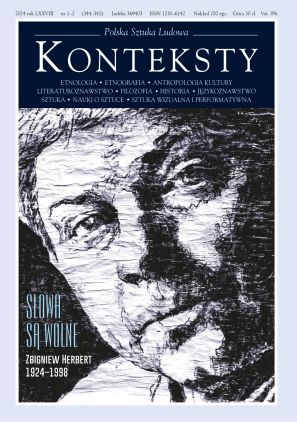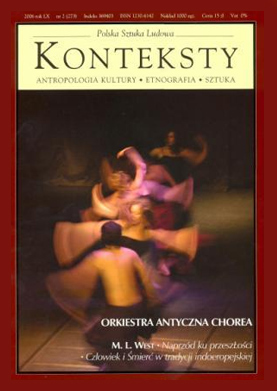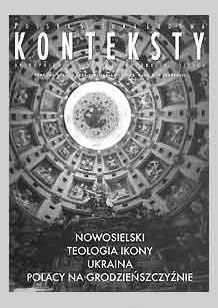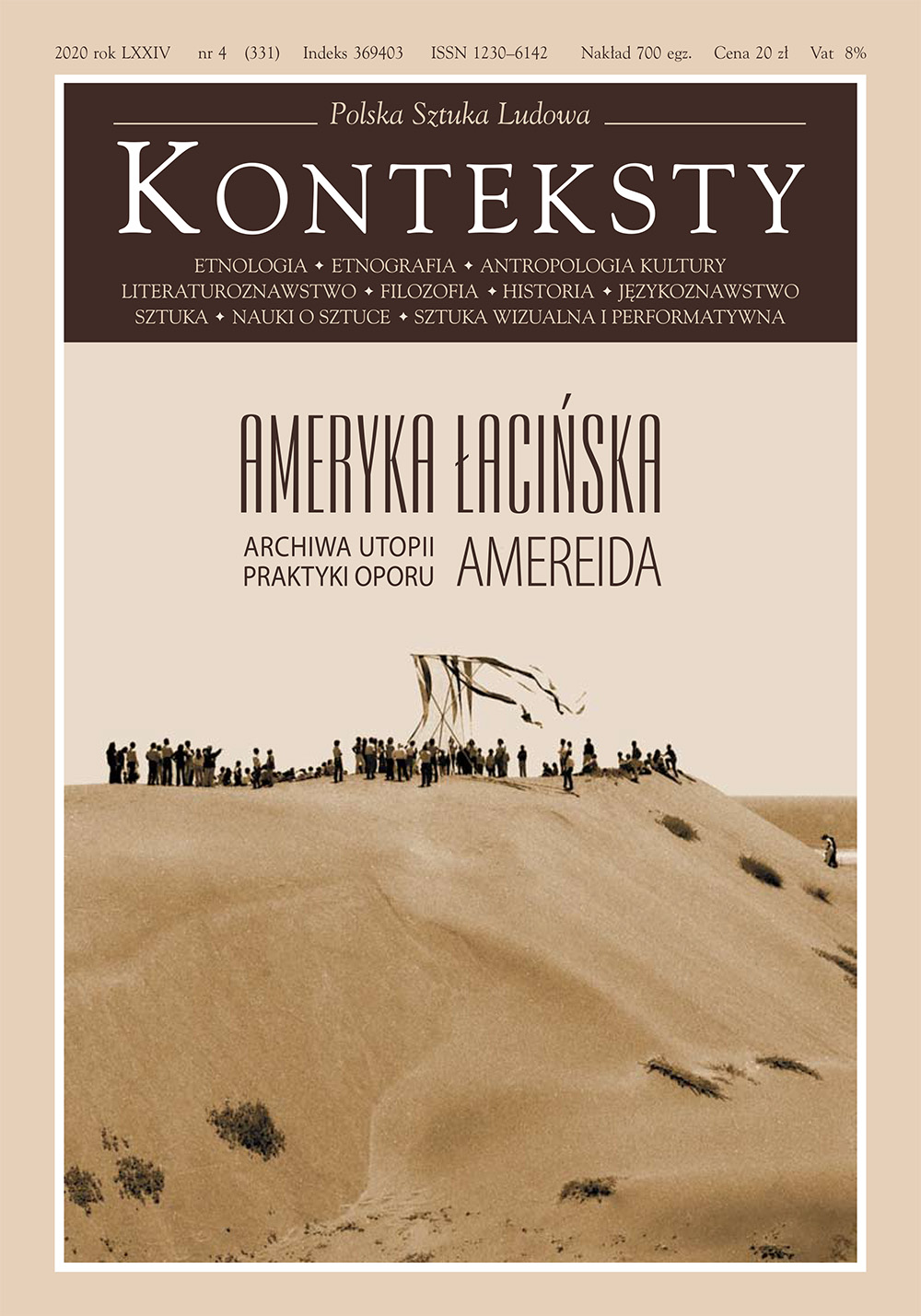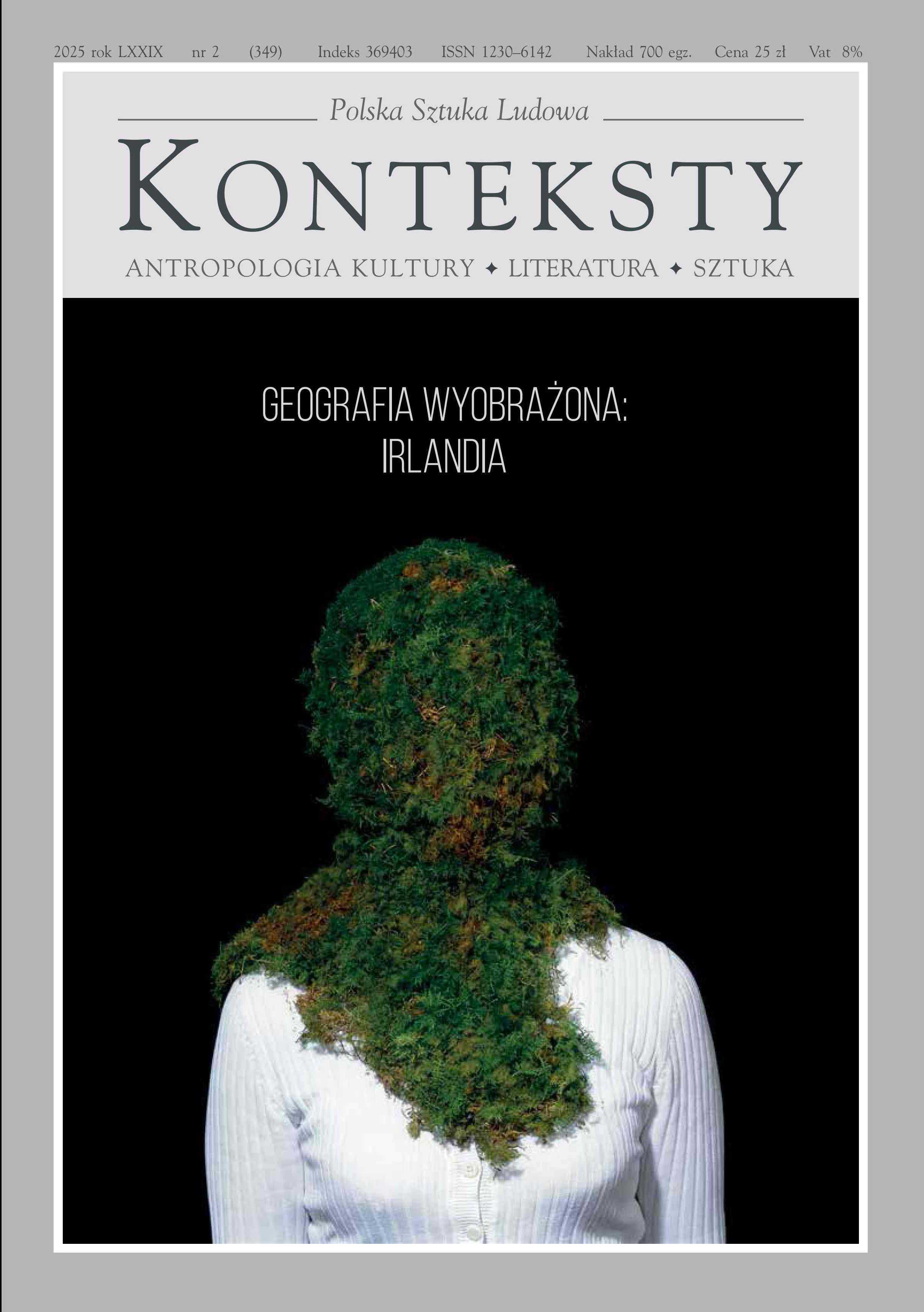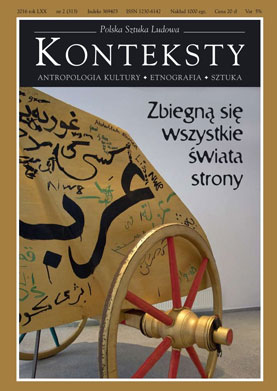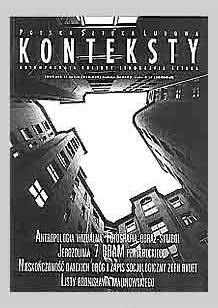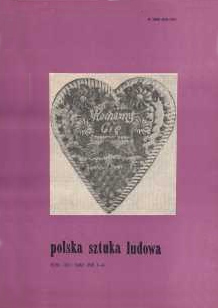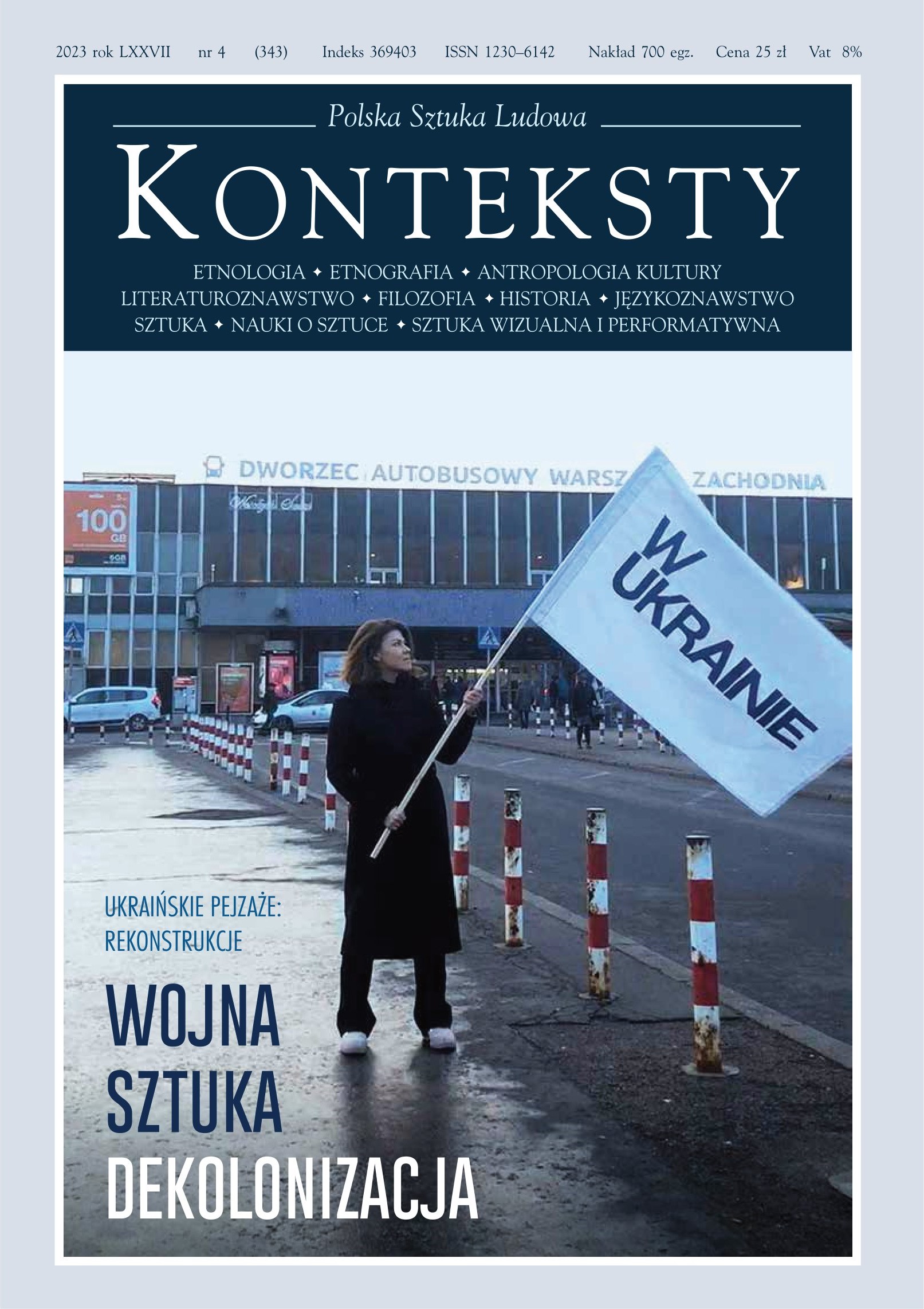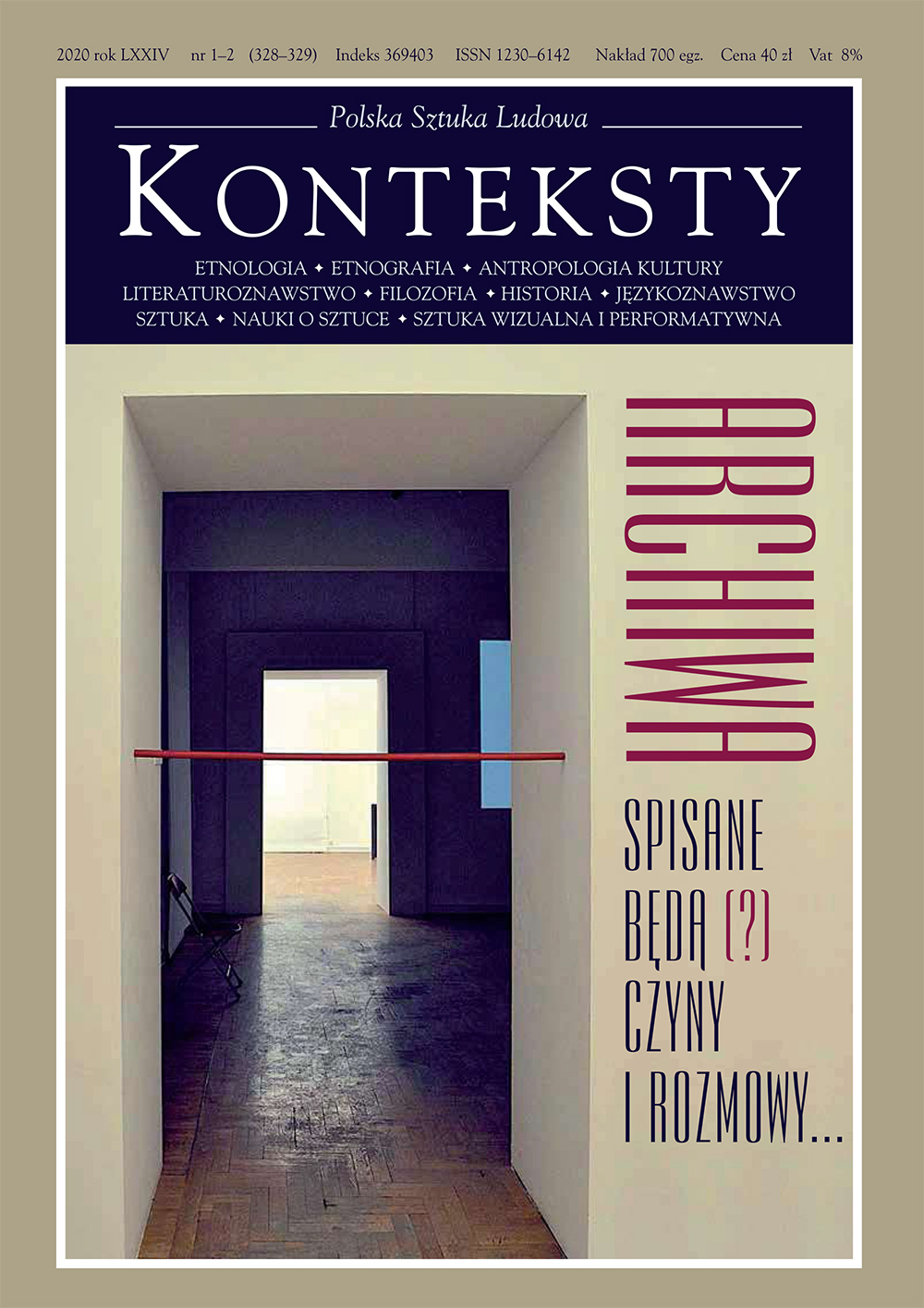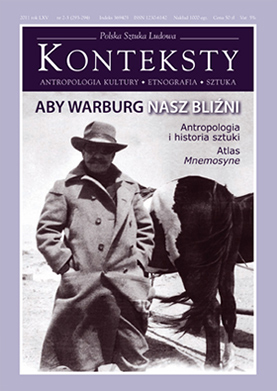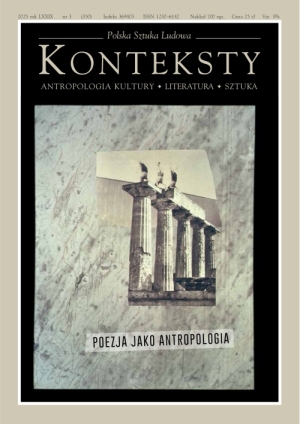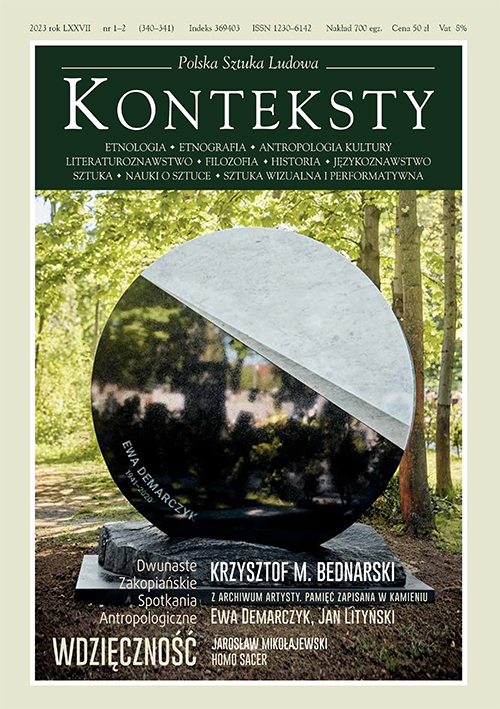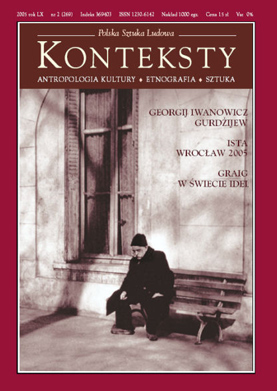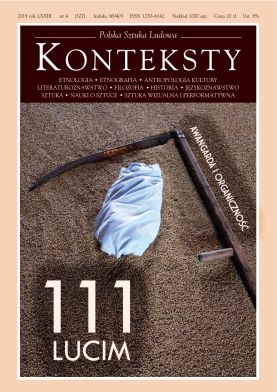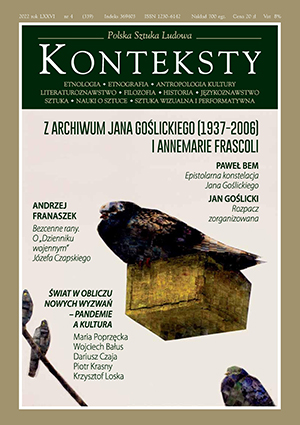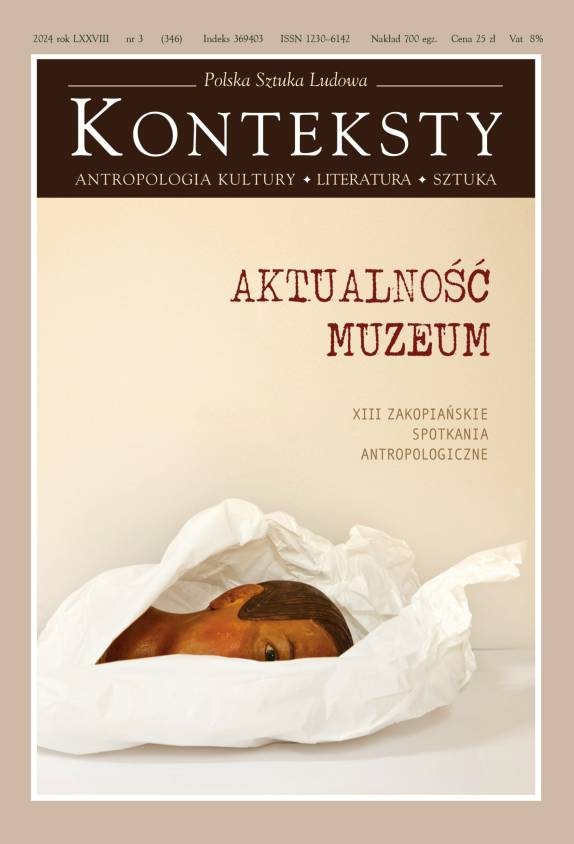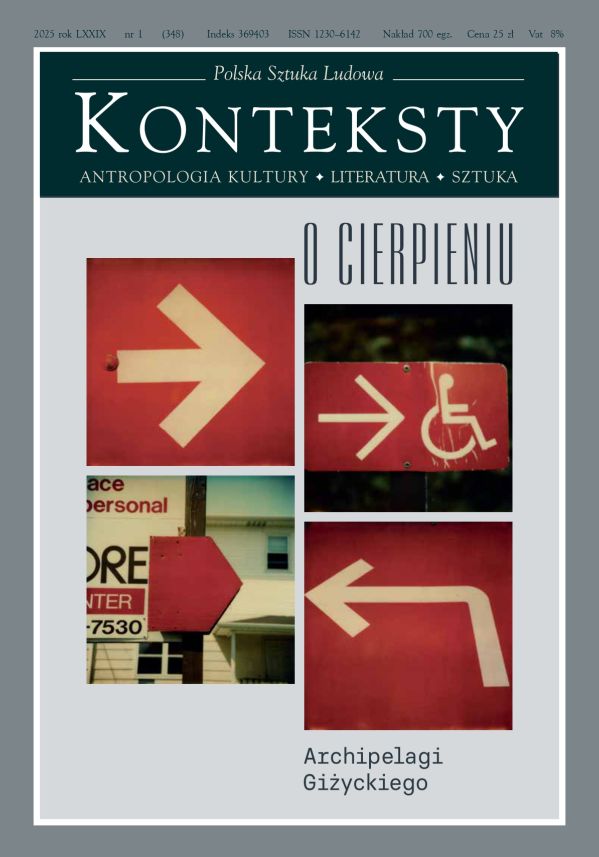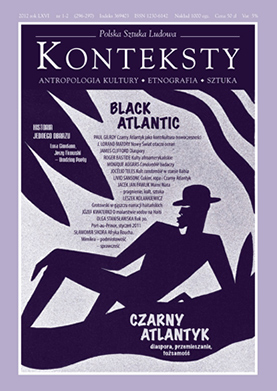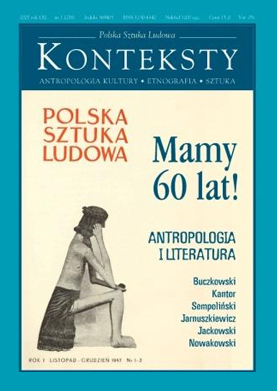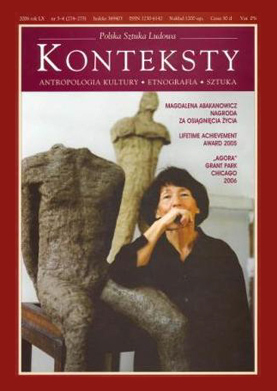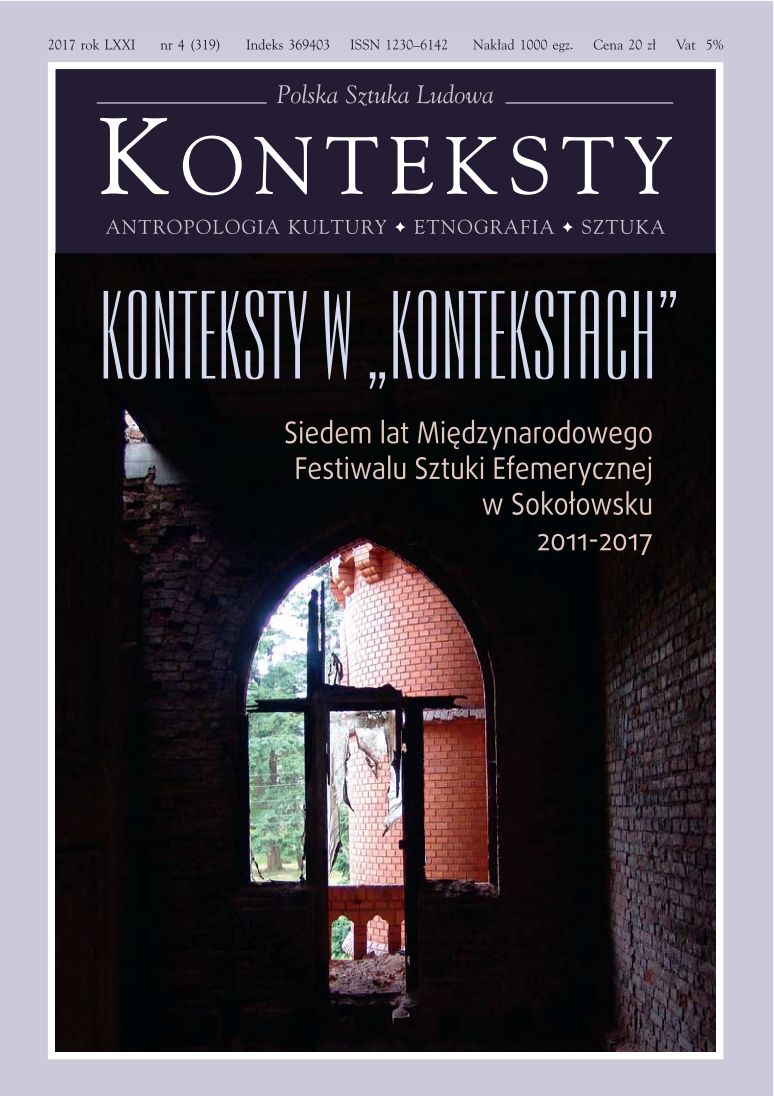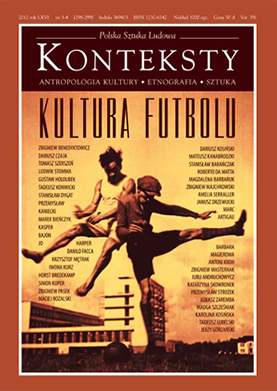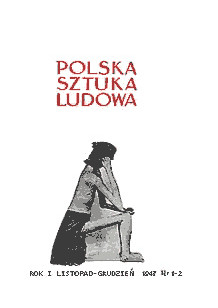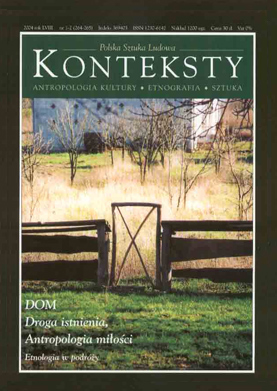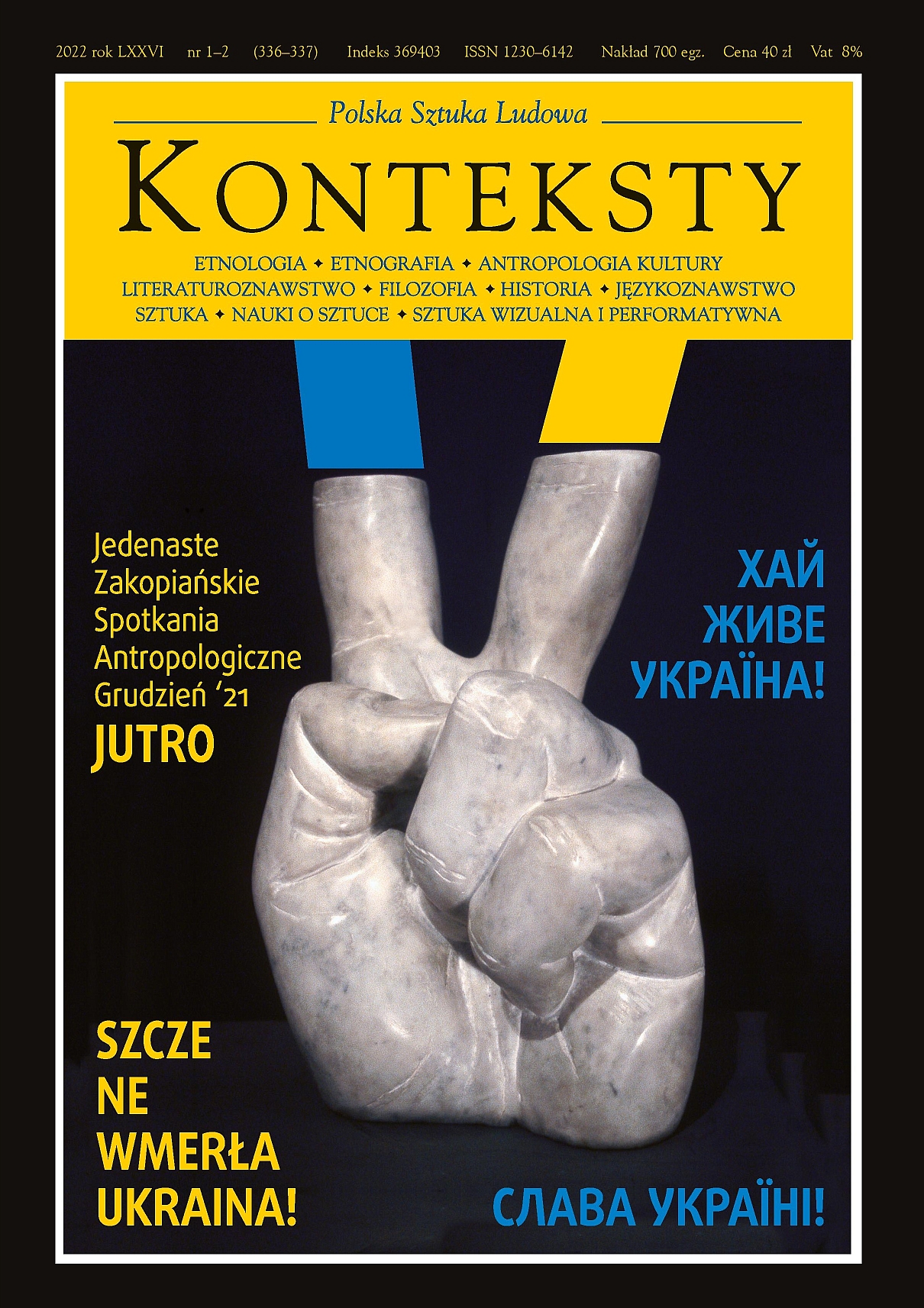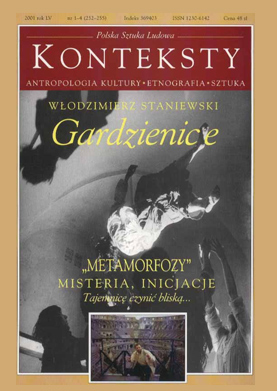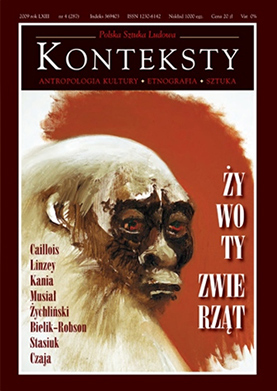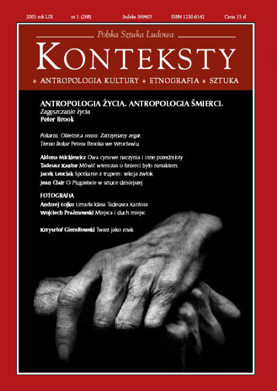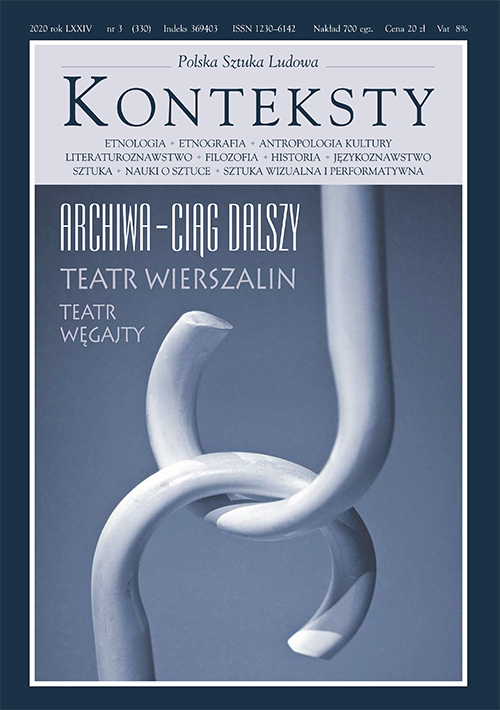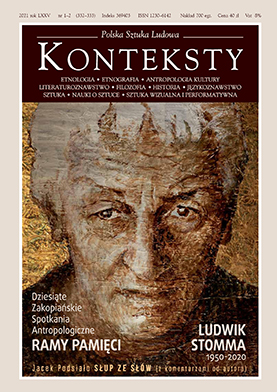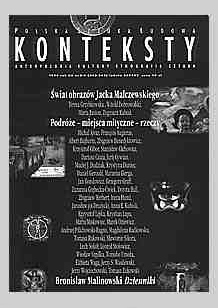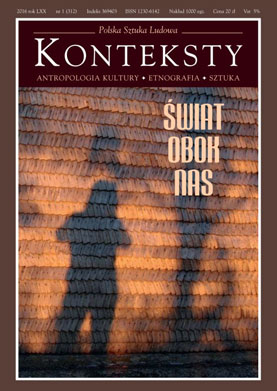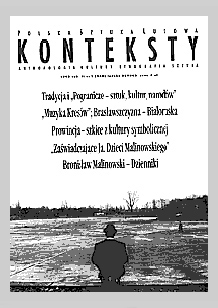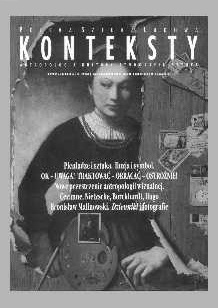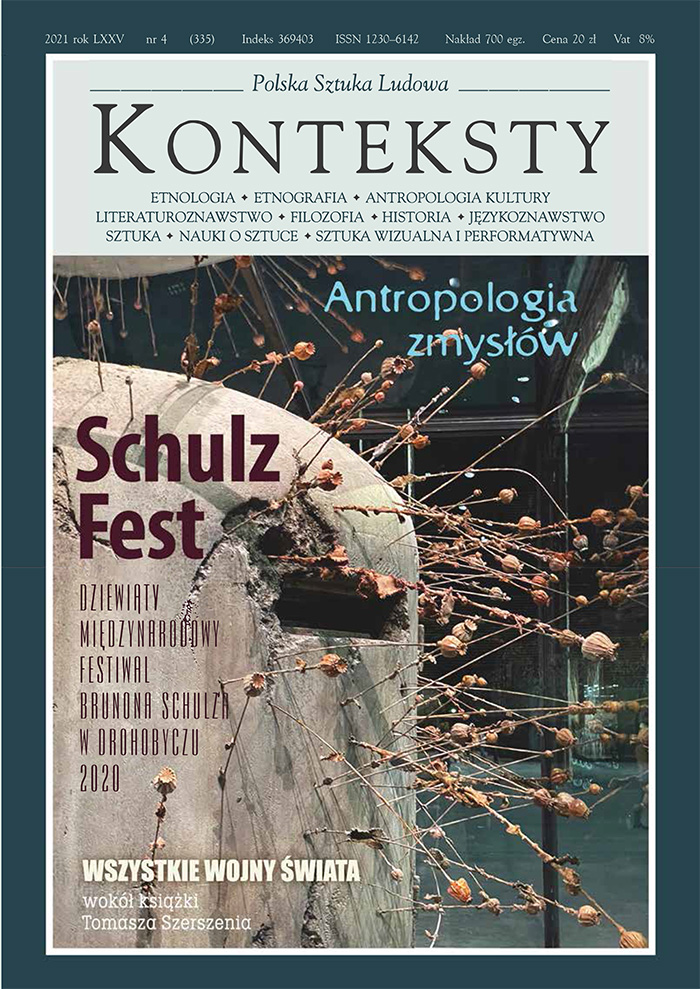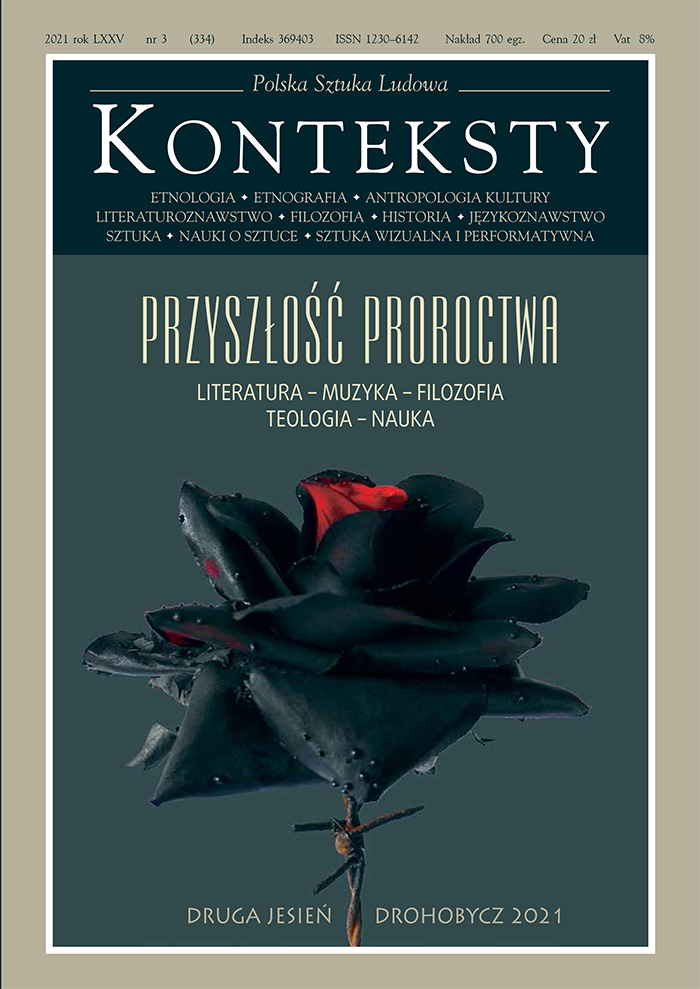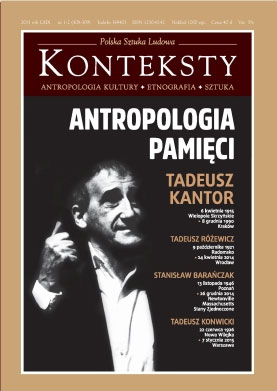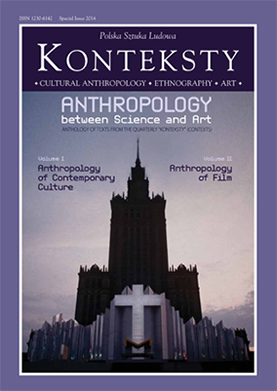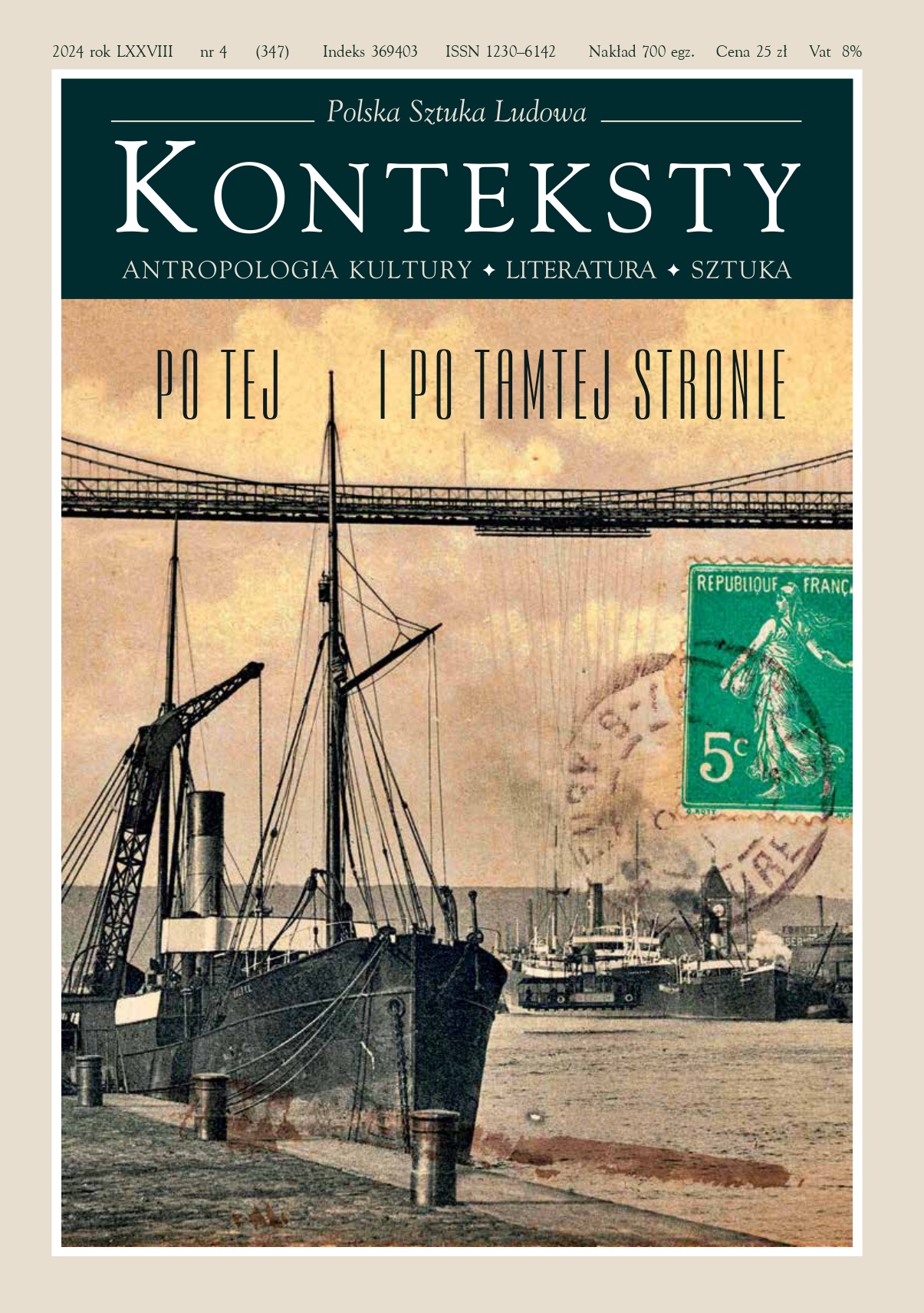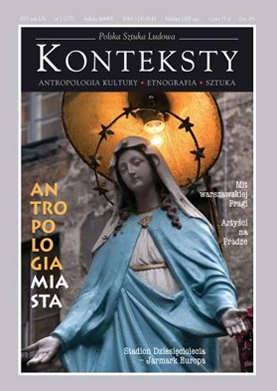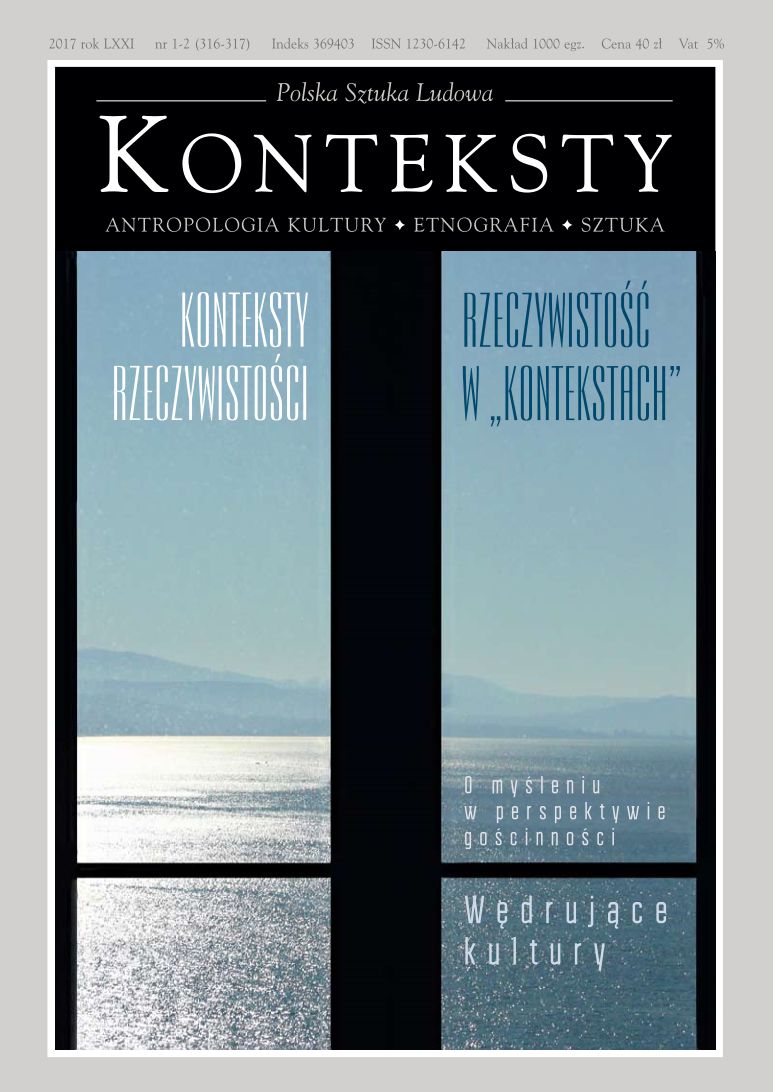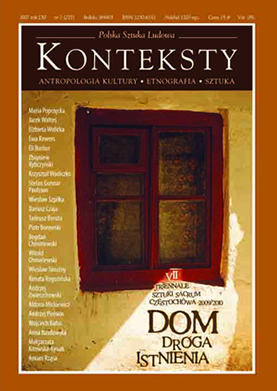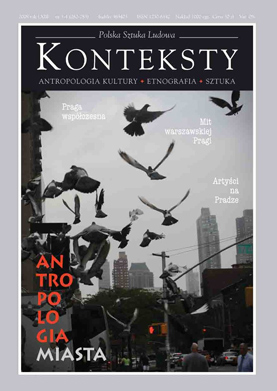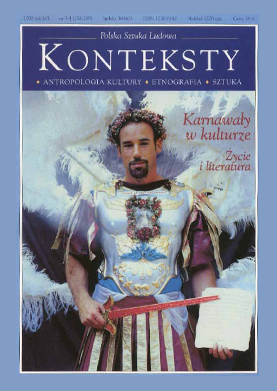Issue 2016/3-4 (314-315) - 70 years of Konteksty
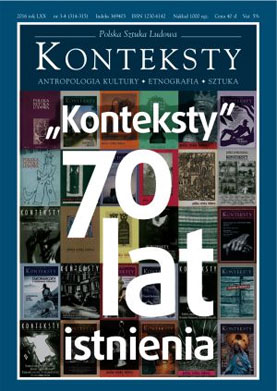
Read the whole issue online  | ||
Read the whole issue here. | ||
| 70 years of „Konteksty” | ||
| Piotr Gliński | On 70th Anniversary of „Konteksty” | 10 |
| Maja Komorowska | On 70th Anniversary of „Konteksty” | 14 |
| Today True [...] Are No More. 5th Anthropological Meetings in Zakopane | ||
| Krzysztof A. Meissner | Today True Certainties Are No More | 17 |
| Michał Klinger | The Second Coming The Problem of the Decline of History  | 19 |
The objective of this study is to indicate the astoundingly topical nature of the evangelical eschatological paradigm (presented in the introduction) by resorting to examples of selected cultural texts. Despite the mass-scale secularisation of our civilisation the process of experiencing such texts is mystical and testifies to sui generis epiphanies uncoordinated with traditional orthodoxy and connected not with doctrine but with the Man Jesus, whose (second) coming grants them the character of an ultimate event. The reflections concern the cultural phenomenon of experiencing the insufficiencies of Tradition, inspired by the theme of the Fifth Anthropological Symposium held in Zakopane in 2015. Selected texts served an analysis of the antinomies of nostalgia and dialectics as well as classical decadence (e.g. Baudelaire’s Le voyage) and mysticism, which reveals its features as “empty ideality” (according to the interpretation by H. Friedrich). The decline of history is illustrated by P. Verlaine (Decadence) and A. Blok (The Scythians). These experiences lead towards a vision of the revolution (in the finale of The Drunken Boat by A. Rimbaud), on the one hand, and towards an astounding revelation of Jesus descending into Hell, an unorthodox experience of the Gospel and Parousia (an encounter with the Bridegroom at the bottom of Hell’s pit), on the other hand. A similarity, difficult to explain, of the sceneries of those epiphanies in Rimbaud’s A Season in Hell and Blok’s The Twelve is indicated. Eschatological epiphanies of Jesus are presented in interpretations by Russian authors: M. Gogol, V. Solovyov, F. Dostoevsky, M. Bulgakov, and B. Pasternak. Emphasis is placed on the important contribution made by the forgotten work by Y. Golosovker: Запись неистребимая / Сожженный роман (1928/1991). All these epiphanies are also analysed from the viewpoint of the idea/figure of the “deceiver” and pseudo-prophet - the Antichrist, of crucial significance in the New Testament. | ||
| Dariusz Czaja | Cain’s Sin Today Real Sinners Are Already No More  | 35 |
Alright: but why Cain’s sin? It appeared to me to be sensible and, in addition, intellectually productive not to discuss sin theoretically, in the language of ethical casuistics or a catechetic talk – as is usually the case – but to start with a certain tangible concrete. For us this concrete will be the story of the crime committed by Cain, told in the Book of Genesis, and the casually associated Cain’s sin. In the culture of the Western world the story of the first homicide fulfils the function of a paradigmatic and model-like narrative. ‘Cain killing Abel – Baudrillard wrote with a certain dose of maliciousness – is already a crime against humanity – and almost a genocide (there were only two of them!)’. Naturally, the crux of the matter does not involve a crime against mankind but rather a paradigmatic evil deed and Cain as a figure of a model-like sinner. This is why the perycope about two brothers continues to be so essential. The Biblical story is not a mere narrative about what took place in mythical remote ages, in illo tempore. Ernst Jünger noticed acutely that together with other Biblical symbols (the original sin, the flood, the construction of the Tower of Babel, etc.) it should be deciphered as a gradual foretaste of that, which is at the source of human history. In other words, it is not only, so to speak, historically important but also remains in a mysterious way topical for us both in our spiritual space and in understanding our hic et nunc. Cain’s sin has not lapsed not only because this original fratricide still casts upon our history a long and ominous shadow (the number of examples would much too large, even from most recent history…). It has also not expired because for many among those for whom the world of Biblical references is not a mere literary fiction it says something important about the nature of sin in general. One way or another, the impact of the background of this bloody event in the Garden of Eden is not an illusion. The sin perpetrated by Cain is still a challenge and a call: a challenge for the discursive mind and academic theology, and a call for a thorough interpretation that abandons well-worn clues. | ||
| Janusz Bohdziewicz | Today True Gods Are Already No More? - or On the End of Religion and the Task of the Spirit  | 50 |
This essay intends to interpret the universally proclaimed (contrary to the actual situation prevailing throughout the world) end of religion and “the death of God” within the horizon of Heideggerian reflection about the tasks of thought in the wake of the end of philosophy. It is also inspired by the writings of Jean-Luc Marion, Marcel Gauchet, Jean-Luc Nancy, and Richard Kearney, constitutes a subjective outline of the history of religion as the history of assorted forms of religiosity, and aims at a deconstruction of the titular conceits: “gods”, “truth”, “are no more” and “already”. Consequently, the author discloses a perspective of thinking about the “resurrection of God”, which transcends the realm of knowledge and requires faith and thus opens up towards the possibility of meeting The Most Important One. | ||
| Krystian Darmach | Today True Visionaries Are No More  | 56 |
The author presents his reflections on the status and presence of visionaries in culture, their assessment, changing functions, and requirements in a text that assumed the form of a philosophical dialogue (conducted in a light-hearted vein) modelled on the Platonic feast, in whose course mythical Gods and Heroes conduct a dispute contesting the role and character of the Visionary as well as the condition of modern man functioning in more or less formal communities. Both the form and the participants of the dialogue are of crucial importance for comprehending the topic and the contents presented within. In these reflections, with the particular parts written out, the author broached upon sincerity, honesty, and decency within widely comprehended interpersonal contacts by evoking such thinkers as Plato or Stefan Themerson, as well as ideas transmitted in the form of a myth and referring to the above-mentioned and, in his opinion, deficit values characterising the genuine Visionary that each one of us could, after all, become. | ||
| Łukasz Sochacki | Are True Biographies Already No More? The Legend of Ettore Majorana  | 60 |
With La scomparsa di Majorana, a book by L. Sciascia, as his point of departure the author tried to solve the question: what is biography as a literary genre? What cognitive and rhetorical procedures create a biographical portrait? Which acts of life deserve to find themselves in a biography? In what proportions are facts and fiction combined in biographical narratives? What is decisive for the credibility of a biographical construction? And what is the essence of biographical truth (or “truth”)? | ||
| Anna Szałapak | „Nothing is obvious” | 67 |
| Antoni Kroh | Winds Blowing from the Tatars, or Where is That Righteousness?  | 68 |
Inhabitants of the Podhale region, who in the wake of Operation Vistula grazed their sheep in the Low Beskidy Mts., left the worst possible memories among the local people – the arrivals devastated Uniate churches and shrines, destroyed the crops, and behaved in the manner of victors in a vanquished land. Little mention has been made of these issues, since they contradict the myth of the “ancient Polish” and “honourable” Podhale highlander. | ||
| Stanisław Krajewski | Real Jews in Poland Are Already No More  | 71 |
When a “Jew boy” appeared on Mt. Zawrat, a fact that Witkacy found so horrifying, no one had any doubts regarding his identity. In post-war Poland, however, after the majority of Jewish survivors had emigrated, the remaining ones were frequently unclear about their identity. After 1968 it seemed that soon there would simply be no more Jews left in Poland, a situation that changed in the wake of the events of 1989. Jewish life underwent a modest but conspicuous revival, with Polishness (language, culture, and customs) as the point of departure for its participants. The process of disassimilation taking place within the range of Polishness results in Jewish involvement, which, nevertheless, does not make these participants less Polish. Are they true Jews? Their status is sometimes questioned. The answer depends on assorted criteria and the world of Jewish institutions has changed in comparison to its pre-- and post-war counterparts but remains genuine. Now the Jews on Mt. Zawrat are different but just as authentic. | ||
| Małgorzata Sady | Alfred Schreyer – Artist of the Spirit from Drohobycz  | 77 |
In 2009-2010 Marcin Giżycki and Małgorzata Sady made the film: Alfred Schreyer z Drohobycza. This is the story of an extraordinary person whom the nightmare of wartime, the loss of his family and motherland, and harsh life in the Soviet Union did not deprive of humanity, dignity, and nobility of the spirit nor undermined his belief in a world of professed values. | ||
| Małgorzata Sady | Alfred Schreyer from Drohobycz  | 78 |
In 2009-2010 Marcin Giżycki and Małgorzata Sady made the film: Alfred Schreyer z Drohobycza. This is the story of an extraordinary person whom the nightmare of wartime, the loss of his family and motherland, and harsh life in the Soviet Union did not deprive of humanity, dignity, and nobility of the spirit nor undermined his belief in a world of professed values. | ||
| Kuba Szpilka | To Be Worse  | 83 |
In his study: Odys gość. Esej o gościnności Cezary Wodziński presented archaic Greek tradition, which unconditionally enjoins the welcoming of the other, the stranger, and granting him our house and the whole world so that they might be at his disposal. The event known as: Zakopane teaches us that today, due to the Jews, the lowlanders, and the tubercular, hospitality requires a confirmation of the existing order and that alienness is seen primarily as a defective, impaired “nativeness”. | ||
| Magdalena Barbaruk | Today Real Coloniality Is Already No More  | 86 |
The purpose of this article is to undermine the thesis about the hegemonic nature of the heritage of European colonization in South America. The author analysed examples borrowed from the celebrated Columbian film: Embrace of the Serpent, directed by Ciro Guerra, and, predominantly, new ideas and solutions associated with questioning European town planning and architectural models. The global career of the idea of the so-called informal city makes it possible to treat South America as a continent of a new urban revolution as well as to alter ways of thinking about the directions of the flux of knowledge. | ||
| Jan Szpilka | “No real masochists left”  | 95 |
This text deals with the figure of a male masochist in the first historical description of masochism as a pathology of erotic life, and with a particular strategy employed by masochists during the XXth century to free themselves from the stigma of sexual deviance. By drawing parallels between the figure of a masochist and a far more acceptable one of a jester or a picaresque folk hero such as Till Eulenspiegel, the author attempts to show how masochism as an identity and a mode of life is capable of tapping into the rich traditions of carnival culture and “world turned upside down”, as epitomized by camp-influenced practices of SM street-fairs. | ||
| Wojciech Michera | “And Then There Were None…”. The Image as a Clue  | 100 |
The opening part of this article, a changed version of a paper read at a conference held in Zakopane in December 2015, attempts a reconstruction of the meeting’s title: Today Real […] Are Already No More. The author considered primarily the significance of the square brackets with paradigmatically ambiguous suspension points ([…]) in the middle as a “clue” compelling to capture that, which has been lost together with the moment of the “loss”, and revealing the significance of the “loss” as an irreducible cognitive principle. Furthermore, the author recognised the “image” as a special variety of such a “clue”. This is why the fundamental part of the article is a critique of Gadamer’s “hermeneutics of the image”, which in a gesture of a wrongly understood apology tries to restore the positive existential rank of the image by ignoring negativity, which is its proper cognitive value. Moreover, the author charged Gadamer with referring in his iconology to the philosophy of Plotinus while neglecting the Plotinian category of “matter” (hyle), of key rank for the philosophy of the image. | ||
| Marian Oslislo | Today Real Authors of Posters Are Already No More  | 107 |
Much has been said and written about the communication role played by the paper poster, which still reigned in the 1990s. New ways of transmitting information and omnipresent cyberspace have completely altered both the forms of communication and that of the communiqué as such. The author attempted to answer a question about the contemporary condition of the poster. | ||
| 70th Anniversary of „Konteksty” | ||
| Anna Chęćka-Gotkowicz | About „Konteksty” | 116 |
| Ewa Domańska | „Konteksty” | 117 |
| Włodzimierz Staniewski, Mariusz Gołaj | It Is a Real Art | 118 |
| Jerzy S. Wasilewski | ”Konteksty” Ethnology – Joyful Wisdom. Flavours of Reading, Pleasures of Writing, Joys of Discovering  | 119 |
The titular “joyful wisdom” refers to an accidental discovery, a lucky chance, and serendipity sometimes experienced by an ethnographer engaged in field work. The author presented three small albeit exciting findings from research conducted in Asia, material testimony of the outright extraordinary connections between Europe and distant Asia. The first is a Russian medal awarded for stifling the Polish uprising of 1863, discovered at a bazaar in Mongolia. The second is a Chinese coin, from whose Mongol (Buriat) name: zos originates – via Russian – the Polish name of a game known as zośka (shuttlecock). The third is a collection of metal circlets excavated in a shaman burial site in Siberian Yakutia, which turned out to be… metal tokens used in card games played in Versailles at the time of Louis XIV. Against this background the author presented the Tsukiji fish market in Tokyo as an institution which, when first encountered by an ethnographer, appears to be ostensibly local and specifically Japanese, but after a more profound examination proves to be global, in the manner of the eye of a needle through which the process of globalisation threads its way. | ||
| Paweł Próchniak | The Actual Presence of Poetry  | 126 |
According to an interpretation proposed by George Steiner poetry calls for a reading that enlivens the backdrop of meanings, grants sense to meaning, and comprises the motion of a transgressive passage from meaning to complete meaning – from the poem’s score to the music of the sense, from a smooth trace to the actual presence of something, which the poem allows to come into being or make its presence known. The author of this sketch followed Steiner’s intuition and extracted the crucial elements of his reflections about poetry. | ||
| Adam Wodnicki | Meeting in The Alyscamps  | 129 |
A literary essay about the Alyscamps – a necropolis, a site for evoking reminiscences and thoughts about one’s misfortune, unfulfilled rejections, and that, which could have been and never was. | ||
| Andrzej Mencwel | Parisian Phantom  | 132 |
I don’t know why it was precisely on this gloomy and wet Parisian morning that I recalled my father. It was spring, but it rained almost incessantly and on the left back of the Seine the sun rose much later than on the right bank of the Vistula, where I reside permanently. I lay in bed, already awake but unwilling to succumb to this state, listening to the rhythmic rattle of raindrops on the sill of a tall window of the palatial townhouse, which for reasons unknown was a boarding house for hard up Polish researchers, and yielded to fleeting egotistical illusions, not associated, however, directly with my childhood or family home, when my father, not so much living as dead, appeared before my eyes or rather my inner sight. | ||
| Piotr Matywiecki | Reflections about the Landscape  | 136 |
How do we know whether something that is located within the horizon of our perception is a landscape and not an interior, a stage? What decides that one sort of space is a landscape and another is not? After all, every landscape can be conventionally described as the interior of another, wider landscape. The difference is determined by the attitude of the observer who prefers either open or closed space. (…) A landscape is an infinitely diverse interpretation of space. Space defines itself, and this is the reason why it ‘knows’ all the places and directions within itself. Looking at a landscape, despite the fact that it brings the latter into being, always seems to the observer to be secondary in relation to space endowed with self-knowledge. | ||
| Jurij Łotman | Text and Cultural Polyglotism  | 139 |
Translation of a text by Yuri Lotman (1992). | ||
| Bogusław Żyłko | Yuri Lotman: from Structural Poetics to the Semiotic Theory of Culture  | 143 |
This text about the intellectual heritage of Yuri Lotman (1922-1993), outstanding Russian semiotician of culture and founder of the Moscow-Tartu School of Semiotics, was written by an expert specialising in Lotman, who translated many of his works into the Polish. | ||
| Michał Głowiński | Seeking Refuge in Folklore  | 147 |
How not to co-exist with Socialist Realism? For numerous men of letters and artists compelled to remain active during a period of obligatory and ruthlessly imposed Socialist Realism this question related to a fundamental issue: how to define one’s place in a world in which draconian political-aesthetic rules had been formulated, how to evade the most radical, i.e. brutally inflicted regulations, and thus how to remain at least partly oneself? Upon the example of works by Paweł Hertz and Jerzy Ficowski, written in the first half of the 1950s, the author analysed the concepts of “folk qualities” and “folklore” as well as their feedback connection with the Socialist Realistic doctrine. In doing so, he demonstrated how “licensed” folklore and folk qualities also became a way of fleeing the dominating ideology and its normative aesthetic. | ||
| Ewa Klekot | Polish Folk Art: Contexts  | 152 |
Located on an intersection of two discourses about art and people, of great importance for the modern system of values, the question of the contexts of Polish folk art and, subsequently, the periodicals: “Polska Sztuka Ludowa” and then “Polska Sztuka Ludowa: Konteksty”, occupied a highly prominent and complicated place within the discourse of the Polish intelligentsia. This text analyses the creation of Polish folk art within the discussion in question, indicating the essential role performed by artistic praxis in this process. At the same time, it tries to show the part played by “Polska Sztuka Ludowa”, which approached the titular phenomenon both affirmatively and critically. | ||
| Antoni Kroh | From a Brigand to an Elephant in Lace Underwear  | 159 |
A droll and sentimental recollection of the author’s over forty years-long cooperation with the quarterly “Polska Sztuka Ludowa – Konteksty”, describing the considerable assistance and kind reception of the then editors: Aleksander Jackowski, Anna Kunczyńska-Iracka, Jadwiga Jarnuszkiewiczowa, and Jacek Olędzki. The collaboration continues until the present day: editor-in-chief Zbigniew Benedyktowicz published fragments of Prywatny leksykon współczesnej polszczyzny by Barbara Magierowa and Antoni Kroh and plans to issue the full version as part of the “Konteksty” library. | ||
| Anna Nasiłowska | “Dyskont słów” – a Sequel  | 162 |
From 2002 the author has been engaged in collecting new words, sometimes curious and ephemeral, borrowed from the English language and published as a dictionary in Dyskont słów. In view of the fact that new words are constantly making their presence known the title of this text announces a sequel. | ||
| Roch Sulima | Demonstrating in the Urban Cultural Landscape. Note’s from a Warsaw Street  | 164 |
The article discusses group behaviour in urban public space, usually described as demonstrations, and situates it within an extensive spectre of assorted forms of social protest. An interpretation of those phenomena refers to methods applied by the anthropology of spectacles and the research procedures of ”urban cultural studies”, including urban ethnography. The article evokes the concept of the “right to look” (J. Rancière, N. Mirzoeff) and poses the problem of the “equality of perception” as a premise for “political equality” (A. Berleant). Demonstrating and watching demonstrations produce something that can be described as a “stage effect”; this is the reason why it is important to observe demonstrations from – generally speaking – the perspective of an anthropology of spectacles and not merely from that of politology or the sociology of social movements. The problems broached in the article are of essential significance for the social history of Polish culture. Group behaviour described within an historical interpretation shows how the Polish national symbolic imaginarium has changed since the nineteenth century, the way in which it shifted from the scenery of a gentry manor house to the space of the large city. The historical perspective accepted in the text makes it possible to portray the wide repertoire of group behaviour, which could be recognised as the “primeval form” of present-day street demonstrations confirming the durability of the so-called resistance cultures and their constitutive role in social life. | ||
| Leszek Kolankiewicz | Grotowski’s Emerald Tablet  | 170 |
Fragment of the book: Grotowski w praniu, to be printed by the Jerzy Grotowski Institute in Wrocław and in English by Icarus Publishing Enterprise as: Grotowski: Lost and Found. At a conference held in Toronto in October 1980 Jerzy Grotowski formulated the pragmatics of his Theatre of Sources. This undertaking was realised at a special time: the first so-called practical seminar took place in the summer of 1980s when a tide of strikes resulting in the establishment of the “Solidarity” trade union swept across Poland. The second practical seminar, planned for 1982, was prepared by an international company touring Poland in 1981 – a period of a tumultuous domestic conflict and a constant threat of military invasion by the Warsaw Pact, which in December resulted in the proclamation of martial law. At the October 1980 conference Grotowski defined the conditions in which the effectiveness of the conducted quests should be tested. | ||
| Rasa Rimickaitė | In Eighty Days Around the World. On Lithuanian-Polish Cultural Relations Especially within the Context of the Last 25 Years  | 187 |
A summary of the activity of the author, who for the past two decades acted as the cultural attaché of the Republic of Lithuania in Poland. | ||
| Antoni Kroh | Half a Century with Wallachian Colonisation  | 194 |
Wallachian colonisation in the Carpathian Mts., treated by Polish historians and ethnographers as a certainty, gives rise to doubts and controversies among the Lemko people. The author compared both contrary points of view and ensuing multiple consequences. | ||
| Magdalena Barbaruk | From Lowlands to Wild Fields. La Mancha vs. Lower Silesia  | 197 |
The purpose of this article is to undermine the thesis about the hegemonic nature of the heritage of European colonization in South America. The author analysed examples borrowed from the celebrated Columbian film: Embrace of the Serpent, directed by Ciro Guerra, and, predominantly, new ideas and solutions associated with questioning European town planning and architectural models. The global career of the idea of the so-called informal city makes it possible to treat South America as a continent of a new urban revolution as well as to alter ways of thinking about the directions of the flux of knowledge. | ||
| Paweł Próchniak | „Konteksty”: The Duty of Truth | 206 |
| Lech Sokół | Attempt at a Critique of the Modern ”I”: Literature – Philosophy – Theology – European Awareness  | 207 |
The author’s understanding of modernity differs from its ordinary comprehension, with the source of his inspiration being Eric Voegelin (1901-1985), in this case predominantly as the author of From Enlightenment to Revolution. Modernity is a disassembly of the paradigms of the culture of the West, founded on Greek rationalism, the Roman legal system, Jewish spiritualism, and Christianity. This process emerged already in the second half of the thirteenth century and its intensification grew at different rates. More, it exerted a fundamental impact on the concept of the “I”. The problem occurred vividly in Ibsen’s drama Peer Gynt (1867), with the “I” appearing as purely instinctual and a register of experiences rendered inedible in an order chronologically reversed in relation to the time of their realisation: from the present towards an increasingly distant past. This is the “I” depicted by Ibsen in his drama and subsequently staged. There took place a parting of ways with the substantial “I”, which proved to be illusory and found its counterpart in the once renowned book by Max Stirner (1806-1856): Der Einzige und sein Eigentum, 1845; in the case of both authors the definition of the instinctual Ego is intriguingly similar although Ibsen probably did not read Stirner and the latter could not have been familiar with Ibsen’s drama. Stirner was also responsible for the appearance of negatively conceived nihilism, of importance for the problem of modern man. An extremely early warning against the illusory and demonic power of the human “I” was made by its unusual interpretation in Teologia deutsch (an anonymous treatise from the second half of the fourteenth century). A great role in the origin of this treatise was played by Dominican mysticism from the Rhineland and, first and foremost, by Meister Eckhart, calling for a rejection of the “I” for the sake of unio mystica with God. The author of Teologia deutsch radically condemned its cult; one of the brief citations most aptly reflecting his approach states: “He who assists man in fulfilling his will [and cultivating the “I”] helps him in that, which is the worst”. In philosophical-aesthetic texts, dramas, novels, and essays written from 1917 to his suicide Stanisław Ignacy Witkiewicz (Witkacy, 1885–1939) defended metaphysical man, the Individual Being, having himself experienced the Great War and the Russian Revolution. Once religion collapses and totally vanishes (which, in Witkacy’s opinion, had already taken place) then art, philosophy, and man, in the traditional meaning of the term, will also become subjected to annihilation. There will remain new and truly modern people de nomine only. As can be seen, the narration of my essay progresses in accordance with the order of the examined problem and not chronology. | ||
| Katarzyna Prot-Klinger | The Opera – Love, Death, Insanity  | 221 |
Upon the examples of well-known operas staged in recent years at Teatr Wielki in Warsaw and the Metropolitan Opera in New York the author demonstrated the manner in which operas refer directly to the unconscious by means of fundamental problems concerning love, death, and insanity. Operas compel us to face the “I – the Other” question, as in The Merchant of Venice or Othello, and immediately pose a question about the Other within me, as in the case of Tristan und Isolde or Turandot. The character of the opera performance in which the plot turns into dream, a figment of the imagination, and an inner drama “assigned” to particular protagonists, undergoes a change. The application of such analytical thinking makes it possible to comprehend the psychological structure of the protagonists and the problem in which it is embroiled. The presented text shows how the opera, while seemingly featuring “insane” dramatis personae, actually refers to the psychic dilemmas of each of us, makes it possible to identify ourselves with them, and turns a night at the opera into a magical ritual. | ||
| Emilia Olechnowicz | “But not my griefs still am I king of those”. The King’s Two Bodies and Shakespeare’s Second Tetralogy  | 231 |
Shakespearean dramas about English history – most frequently known as chronicles (histories) – can be perceived as a great study of the multiple aspects of the phenomenon of power, dealing with legitimisation and usurpation, loyalty and treason, and tyranny and helplessness. They are also interpreted as “mourning plays” in the sense proposed by Benjamin, in which the characters of the kings function as semi-allegorical dramatis personae waging a duel involving power and helplessness. The chronicles produce a vision of a world submerged in a crisis and eternally on the verge of war. They take place in a well-ordered world suddenly destroyed by violence or in a devastated world that has to be controlled by resorting to violence. Peace – assuming that it exists – is fragile, just as is authority, constantly threatened by intrigues and conspiracies, but also by the ruler’s inner weakness. Paradoxically, they thus tell a story in which sole power belongs to the monarch but cannot be effectively wielded by him. These histories accentuate also the irremovable dissonance between the majesty of the throne and the condition of the person sitting on it or, to resort to terminology introduced by Ernst Kantorowicz – between the King’s Two Bodies. The theory formulated in Elizabethan England was supposed to become a universal and unconquerable principle of the monarchy. Shakespeare, meanwhile, demonstrated vividly that it is wavering and easily questioned. In his second tetralogy he described the great crisis of legitimisation, whose outcome is an irreversible change in the comprehension of power. | ||
| Krystyna Bartol | The Maritime World of Oppian, or On the Interpretation Contexts of “Halieutiká”  | 239 |
The poem by Oppian (end of the second century A.D.) – a continuation of the tradition of the great didactic epic describing the inhabitants of the underwater world as well as the people skilled in capturing them – Is an example of an erudite dialogue with the literary past, omnipresent in post-Classical Greek culture. In her concise depiction of the interpretation contexts of On Fishing K. Bartol concentrated on presenting the author of the poem as a man of letters conducting an emulative game with the aesthetic paradigms devised by his predecessors. In doing so, she tried to prove that this is a game subjected to a supreme ideological objective, i.e. a recollection of ancient (epic) world outlook concepts, and indicated their universality. A glorification of the ethos of rivalry, consolidated by Homeric epic poems and in this case transferred into a new context, together with legible allusions to the ancient discussion about the relation between Nature and culture, aims at recognising the superiority of the latter. The article concentrates on demonstrating the finesse of Oppian’s game played with the past, a sophisticated process of embarking upon assorted themes, subtle allusions, verbal virtuosity, and the art of constructing subtexts. K. Bartol drew attention to the pragmatic transformation of these features, which in their original context are perceived as an expression of an artistic homage paid to the Greek past and the retention of the vitality of Greek ideals, which in the world of Roman domination become the determinants of an author’s mastery; freed from a genetic connection with the cult of ancient Hellas they are the reason for Oppian’s popularity (as well as that of similar authors) among successive readers all the way to contemporary times. The anthropomorphising perception of non-human worlds proposed by Oppian could prove to be close to our conceptualisation of seeing the world regardless of the cultural hinc et nunc. | ||
| Włodzimierz Lengauer | The Greeks and Eros  | 245 |
In the course of a symposium described by Plato in one of his most famous dialogues, speakers gathered at the residence of Agathon embarked upon the topic of eros and pondered the behaviour of people inspired by love as well as the nature of love stronger than human will and intellect. The Greeks regarded Eros predominantly as a deity who emerged from Chaos, i.e. a primeval force that rendered further cosmogony possible. At the same time, the use of the concept of eros as a common noun points to a conviction that it is an invincible and irresistible force, which overcomes man regardless of his will. The state of being in love is tantamount to mania erotike, which Plato described in Phaedrus. Just like other varieties of mania it too is one of the greatest gifts bestowed by the gods. This particular gift comes from Eros and Aphrodite, but it can turn out to be menacing and outright dangerous. A person succumbing to mania erotike must be aware of the impact of eros and subject his behaviour to certain norms and principles, thus making proper use of this gift received from the gods. Such use entails, first and foremost, directing his passion towards a person worthy of it, and then seeking not so much sensual fulfilment as spiritual harmony with the beloved. The speakers in Plato’s dialogue discuss almost exclusively a love of boys, but in later Greek thought (Aristotle, Plutarch) all love is at stake, regardless of biological gender. Aristotle claimed that bodily contacts always result in emotions (philia). Sensuality is, therefore, subjected to the emotional sphere and is to be the foundation of a relation between two individuals based on reciprocity. The god Eros might regard unrequited love to be a misdemeanour committed against him and harshly punish the guilty party. The object of the religious cult in Olympia, Elis, and Athens was not only Eros, but also Anteros (“love returned”). Erotic relations between mortals remained in accordance with the will of Aphrodite, Eros, and Anteros, whose protection they enjoyed. | ||
| Kazimierz Mrówka | The Evil Bull of Phalaris  | 251 |
The author of this article interpreted the concept of the bull of Phalaris: 1. Historically: the brazen monster to which a meaningful image of human and, at the same time, inhuman life adhered, left its material imprint in history, as testified by historians, poets, men of letters, painters, and philosophers. 2. Symbolically, with symbols referring to human existence contaminated by evil and suffering. This is the sort of life that is commonly described as turning into torture or the very onset a life within the fiery entrails of the beast. At the same time, the bronze bull is one of the symbolic avatars of evil. | ||
| Urszula Makowska | Derwid’s Paintbrush  | 258 |
Up to now, the painter Jan Świerczyński (1882-1973) has been absent in the history of Polish art. He remains known almost exclusively as the father of the poetess Anna Świrszczyńska, who presented his biography in the Wiersze o ojcu i matce series (1985) and in several statements made in her prose. The artist’s only one-man show took place at the Zachęta Gallery in Warsaw in 1928. The works on display included a composition inspired by Lilla Weneda, a drama by Juliusz Słowacki. Its symmetric configuration, formal references to folk art, and departure from the rules of painting are decisive for close analogies with the structure of the play, which could be derived from the puppet theatre. By granting the dead Lilla features of the Madonna Świerczyński combined the fifth and eighth (closing) scenes of the drama into a single whole. The source of this sacralisation of the female protagonist was the litany apostrophe of King Derwid, who only after his daughter’s death assumed the role of a father. The motifs of incestuous love between a father and a daughter (or patricide), dominating the contemporary discourse, appear to be applied to a limited extent in the interpretation of both Słowacki’s Lilla Weneda and Anna Świrszczyńska’s poems about her father. | ||
| Piotr Kłoczowski | Mnemosyne. Miscellanea  | 268 |
An introduction to the Mnemosyne Library – a series prepared by the słowo/obraz terytoria publishing house under the supervision of, and edited by Piotr Kłoczowski. | ||
| Roland Barthes, Daniel Boudinet | Georgics  | 268 |
Twelve photographs by Daniel Boudinet and accompanying commentaries by Roland Barthes (which assumed the form of concise georgics), originally published in the periodical “Créatis” in 1977. | ||
| Edgar Morin | Le retrouvé et le perdu  | 277 |
An essay-reminiscence by Edgar Morin about the works and life of Roland Barthes, originally published in the periodical “Communications” in 1982. | ||
| Marguerite Yourcenar | Sur un rêve de Dürer  | 279 |
An essay by Marguerite Yourcenar, originally published in the periodical “Hamsa” in 1977 in an issue about esoteric motifs in Dürer’s œuvre. | ||
| Marguerite Youcenar | Deux Noirs de Rembrandt  | 281 |
An essay by Marguerite Yourcenar written in 1986 and originally published in “Le Monde” – a reflection on an unusual Rembrandt canvas. | ||
| Dariusz Czaja, Wiesław Juszczak | Conversations about the Cinema: Bergman, Buñuel, Wajda  | 283 |
A recorded conversation held by Wiesław Juszczak and Dariusz Czaja about three outstanding film directors: Ingmar Bergman, Luis Buñuel, and Andréa Wajda and their works. This fragment is from: Ruiny czasu albo o twórczości. | ||
| Magda Heydel | Translation: the golden bough  | 296 |
In July 2013, a month before he passed away, Seamus Heaney finished his work on the translation of Book VI of Virgil’s Aenaid, a text that had belonged to the most important literary inspirations for him since he read it as a young student. He returned to it throughout his own writing. traces of this “lifelong presence” are well visible in many of his poems. In 2016, three years after Heaney’s death, the translation was published under the careful editorial eye of Catherine Heaney and Matthew Hollis. The fact that it is with this particular text that the poet comes back to his readers from the “other world” is striking and significant, as Book VI of Aenaid tells the story of Aeneas’ travels to Hades to meet his father. The essay aims at reading of Heaney’s translation in the context of his fascination with Virgil, some important motives of his writing and the concept and role of translation in his oeuvre. | ||
| Jerzy Bartmiński | On 70th Anniversary of „Konteksty” | 302 |
| Katarzyna Barańska | Museum of „Konteksty” | 304 |
| Barbara Major | „Konteksty”: My Connections | 309 |
| Zbigniew Benedyktowicz | Sacrum and Art. Life and Art. Conversation with Jacek Sempoliński and Wiesław Juszczak | 312 |
| Ewa Domańska | Animal History  | 322 |
This article reflects on Animal History as a subfield of the discipline of history. Its main goal is to identify the new research prospects and potentials. These include such topics as the problem of “the animal’s point of view,” animal agency and animals understood as “historical” agents and actors and searching for new historical sources (including animals’ testimony). It also explores methodological difficulties, especially with the idea of the historicization of animals and the possible merger of the humanities and social sciences with the natural and life sciences. The article considers how studying animals forces scholars to rethink history as a discipline to its foundations. It claims that the most progressive proposals are coming from scholars (many of whom are historians) who advocate radical interdisciplinarity. The authors are not only interested in merging history with specific sciences (such as animal psychology, ecology, ethology, evolutionary biology and zoology), but also question basic assumptions of the discipline: the epistemic authority claimed by historians for building knowledge of the past as well as the human epistemic authority for creating such knowledge. In this context several questions emerge: can we achieve “interspecies competence” (Erica Fudge’s term) for creating a multispecies knowledge of the past? Can research in animals’ perception of change help us to develop of non-historical approaches to the past? Can we imagine accounts of the past based on multispecies co-authorship? | ||
| Sławomir Sikora | Why Look at Animals? – “Nénette”  | 332 |
Forty years ago John Berger wrote a text under the same title. He also dedicated a different piece of writing to Nicholas Philibert – philosopher and filmmaker, author of the film: Nénette (2010). This essay is an interpretation of the latter work and an attempt at demonstrating how, despite its simplicity, it remains pioneering (not only in reference to ideas launched by Ray Birdwistell and going back to the 1960s and 1970s). Simultaneously, it shows how much has changed in our perception of, and approach towards animals during this seemingly brief period. Finally, it pays homage to John Berger and his insight, revolutionary for its time. | ||
| Tomasz Gruszczyk | Zygmunt Haupt: to Attribute Alien Qualities, to Attribute Oneself  | 337 |
The experiences of the narrator-protagonist of Zygmunt Haupt’s prose, similarly to the author’s life story, are delineated by a sequence of places, events, and people encountered in the course of his journeys. The author endowed his protagonist with the role of a voyager, an arrival, and an exile. The question concerning the status of those figures naturally also pertains to the model of subjectivity contained in the writings. The prime target of this essay is to indicate that the art of subjective existence in works by Zygmunt Haupt is tantamount to the art of discovering oneself in that what is different as well as amongst others; it denotes delineating common spaces or, better still, a territory of a community, some sort of We. To put it differently, in this prose to be a subject means to be subjected to a meaning that, first, becomes constituted within a space and with the assistance of that, which is shared (language, culture); secondly, it is always historical, inconstant, and labile. To be oneself will thus denote being not only an open being but also a dialogical one. The reflections of I will become possible only once the I of another is noticed and accepted; the same holds true for the I of the community. Here, the instrument applied for attaining such a goal consists of thought and speech, while the possibility of a conciliatory dialogue comes into being as the effect of the effort of emphatic comprehension emerging from moral responsibility (an obligation to respond thoughtfully to the voices of the others). This is already the heritage of a certain historically defined ethos – that of the 1910 intelligentsia. | ||
| Jacek Leociak | Niska Street  | 351 |
Fragment of the book: Biografie ulic. (Żydowskie ulice Warszawy: od narodzin po zagładę), to be published in the autumn of 2017. The essays focus on 12 selected streets comprising a group portrait of this fragment of Warsaw, most densely populated by Jewish residents and known as the northern or Nalewki-Muranów district; here local Jews worked and co-existed with the Poles but often comprised an overwhelming majority endowing this part of the town with a specific and distinctive character. The narration pertains to the centuries-old history of the streets and their inhabitants, the culmination being the period of the ghetto and the Holocaust, although the publication is not restricted exclusively to this period but delves into the more distant past and focuses on the present. In this manner it outlines a comprehensive ”biography” of the streets: from prehistory to contemporary times, from their origin to the Holocaust, and from a catastrophic severance of a continuum, emptiness, and non-existence all the way to the present day. The methodological inspirations of such an interpretation are located, to put it in most general terms, within a domain of a “topographic turnabout” in contemporary spatial anthropology and urban studies. | ||
| Katarzyna Bojarska | Non/salvation. Ecce Maryan S. Maryan  | 364 |
An analysis of the experimental film: Ecce homo (1975), one of the last works of the Polish-Jewish artist Maryan S. Maryan, conceived as a sui generis memory performance within the context of the genre of the testimony video, soon to emerge at the time. The author analysed this extraordinary record of an experience as a special case of traumatic memory, deriving its force from an observant experiencing of the present, politics, and history. | ||
| Ewa Andrzejewska | Maryan. Revival  | 371 |
Fragment of a book about Maryan (Pinchas Burstein, 1927-1977), a painter of Jewish descent born in Nowy Sącz and a Holocaust survivor, to be printed by the Nisza publishing house. After the war Maryan lived in Jerusalem, Paris, and New York, where in 1975 he made Ecce Homo, a film based on his horrifying plight and not worked through experiences as a concentration camp inmate. | ||
| Marcin Trzęsiok | Open and Concealed Beauty  | 373 |
Today, the process of embarking upon the theme of beauty resembles setting off on a journey to Atlantis or some other legendary land about which we know only that, which had been written in ancient tomes. (…) Beauty has become unreliable and thus relegated to the shadows. Some find this relegation to their liking, while others are troubled by it. Such polarisation is the reason why a debate about beauty assumes an ideological hue, and instead of observing and testing the credibility of the arguments we often find ourselves on a battlefield where it is so easy to lose one’s head. I wonder how to find myself since I feel that important arguments are arranged equally on both sides and, in addition, incessantly pass from one camp to the other. How is one not to share the doubts voiced by Yeats, namely, whether a work of art, regardless how proportionate and luminous it might be, can become a gate open to the extra-sensual world? On the other hand, how is one to trust those who believe upon an unknown basis that beauty always lies – as if the crisis of metaphysics would perforce deprive it of all meaning? | ||
| Maria Poprzęcka | Chalk Cliffs  | 378 |
The chalk cliffs on Rügen were introduced into (the) history (of art) by a famous painting by Caspar David Friedrich. The contrast of this topos and a less well-known dramatic World War II episode (the evacuation by sea of the inmates of the Stutthof concentration camp) becomes a point of departure for reflections on “the phenomenon of memory” in contemporary art, the tangle of private and group memory, the question of travelling (“going on a pilgrimage”) to places associated with concrete artists and their works, and, finally, the essence of perception of the sort experienced by the historian of art. | ||
| Jacek Sempoliński | Journals 1999-2007 Fragments  | 384 |
Jacek Sempoliński wrote his journals for almost ten years – the last decade of his life (1999-2008). Their copious edition (over 500 pages long): A me stesso was published by the Institute of Art of the Polish Academy of Sciences (selection by Wiesław Juszczak, edited by Emilia Olechnowicz). | ||
| Monika Krajewska | Jewish Paper Cutting. Image and Word, Tradition and Non-tradition  | 391 |
The authors of Jewish ritual art did not find the mere image satisfactory and upon numerous occasions introduced texts – Biblical verses, the words of prayers, and blessings – for the purpose of supplementing ornaments and symbols. Suitable examples may be found in, i.a. painted decorations of synagogues, embellished Torah scrolls, embroidered curtains of the ark containing scrolls, matsevah bas-reliefs or papercuts. In what manner does the image correspond to the text? Certain texts are devoid of corresponding illustrations some are illustrated directly, and some visual arts motifs are not accompanied by a text, but it is still possible to decipher inspirations borrowed from a concrete fragment of the Torah, the Talmud, or Midrash literature. The presence of verses in the case of visual art depictions facilitates the interpretation of their symbolic meaning whenever we are dealing with an ambiguous symbol. This subtle game played with the image and the word has inspired Jewish artists from the distant past to this very day. Take the example of the Jewish papercut, which flourished in particular in nineteenth-century Eastern Europe. From their earliest schooling the authors of such papercuts were familiar with the Torah, the Talmud, and other exegetic texts. Their works fulfilled assorted functions in ritual life as well as within the annual and life cycle, and calligraphic texts depended upon such purposes. When the author of this essay became interested in Jewish paper cutting she was enthralled with the manner in which folk artists expressed diverse contents by means of lacy paper images that did not observe the principles of proportion and perspective or the law of gravity. She regards their works as an inspiration, albeit by no means the sole one, and derives assorted motifs also from Jewish tradition outside the canon of the papercuts of old as well as from her own experiences. This approach is reflected in the I Seek Paradise, Dybbuk, and Burning series, works combining frottages from matsevah bas-reliefs with the papercut, and the Tatras and Psalms series. The author perceives the mountains as a place where the Psalms and the elements meet. Here beauty and awe are so powerful that they are equalled only by Biblical comparisons and blessings said while viewing imposing summits or lightening or hearing the sound of thunder: “Blessed are You, Hashem, our God, King of the universe, for His strength and His power fill the universe”. This is why in this particular series impressions generated by the world of the mountains are collated with verses of the Psalms and other Hebrew religious texts. The Tatras and Psalms exhibition is presented at the Museum of Zakopane Style at Villa Koliba, a branch of the Tatra Museum; its opening accompanied an anthropological conference organised by the editors of the quarterly “Konteksty” and the Residents of Zakopane in Search for Identity Foundation. | ||
| Jacek Waltoś | What Was “Wprost” to Have Been?  | 400 |
This essay endeavours to solve a question about the character of the “Wprost” group: a chance to create a community of persons (probably as a reference to Personalism) expressing within an artistic and social context experiences shared with recipients without enclosing themselves within the range of art and the autotelic character of its goals and tastes. As an informal group of friends “Wprost” believed in the language of images also by resorting to the tradition of European art and its iconological interpretation. It rejected post-Kapist aestheticization – this being a period of a strong impact exerted by the norms of that particular group – and the progressiveness of avantgarde extremists. | ||
| Barbara Osterloff | Edmund Osterloff – Artist of the Image  | 402 |
Edmund Osterloff (1863-1938) is one of the precursors of Polish art photography and a representative of a current known as pictorialism, the author of already classical works included into so-called native photography. His most complete statements assumed the form of photographic landscapes and studio portraits executed brilliantly in the bromoil technique. Already prior to the First World War Osterloff’s works were awarded abroad and then brought their author the acclaim of a “Polish Léonard Misonne” as well as an invitation to join the elitist Polish Photo-club established in 1930. B. Osterloff used unknown documents to present the unusual biography of this Pole by choice and émigré-exile, who spent 25 years in Georgia where he inaugurated his career as an artist. Naturally, the coincidence of names is not accidental – the author and the titular protagonist of the essay are related. | ||
| Tomasz Swoboda | Two Contextual Photographs  | 413 |
This two-part essay focuses on two photographs: Image irrationnelle, by Raoul Ubac and a portrait of Michel Leiris standing next to a sculpture of the African god Gu. The former inclines us to consider the boundary between man and animal, and the latter to reflect on the status of the autobiographical quality in the process of creation. | ||
| Tomasz Szerszeń | Notes about Neorealism. 1947  | 416 |
Cesare Zavattini wrote that Neorealism remained an art of “fragmentary, ephemeral, piecemeal, missed encounters”. This text is an attempt at examining “Neorealist” photographs taken in the 1950s by Marek Piasecki, Jerzy Lewczyński, Zofia Rydet, Zdzisław Beksiński, and Tadeusz Rolke, and their relation towards the cinema, i.e. as takes from a never made Neorealist motion picture. Neorealism, together with its programme-like escape from subjecting reality to any sort of initial premises, its inconclusiveness, flight from didacticism, and finally – and this feature is perhaps of key importance – its unclear perception, was a sui generis “materialistic metaphysics of everyday life”, disclosing the ambiguity of a world shattered into fragments. By the very force of things, photographs taken by Piasecki, Lewczyński or Beksiński and evoking this aesthetic, became an instrument of a decolonisation of perceiving the reality of the early stage of People’s Poland, showed the then “undepicted world”, and, finally, was a sui generis visual, non-academic “anthropology”. The pretext for these reflections is the year 1947: a time of the worldwide triumph of the Neorealist cinema, the beginning of rebuilding Warsaw, the onset of Stalinism in Poland, and, finally – and this could be of utmost prominence – the year of the establishment of the periodical “Polska Sztuka Ludowa” (today: “Konteksty”). | ||
| Adam Mazur | Partial Object. A Synthesis of the Works of Aneta Grzeszykowska  | 423 |
This text presents the state of research, proposes a systematic approach, and, upon its basis, conducts a synthesis of heretofore works by Aneta Grzeszykowska (b. 1974). Despite a number of press articles as well as critical and scientific texts, Grzeszykowska’s œuvre continues to evade reflections while the relatively large number of her one-man and group shows becomes the reason why an outside observer finds it difficult to establish the sequence of her projects and relations within the range of particular sets of works. This text contains a chronological reconstruction of Grzeszykowska’s artistic development spanning from her early student works, executed together with Jan Smaga, to the most recent undertakings, whose effects are shown at exhibitions held in Poland and abroad or are published as art books (e.g. Negative Book or Selfie). A. Mazur arranged the artist’s oeuvre in order from the vantage point of its themes (initial interest in architecture, questions of identity and objectivity, pastiche and repetition, feminism) and the media (from photography via video to sculpture and performance). A reconstruction of the state of research and an amassment of possible paths of interpretation enabled the author to present his personal vision of Grzeszykowska’s art. | ||
| Maciej Rożalski | Yanka’s Anthropologies  | 429 |
This article about the Polish dancer Yanka Rudzka attempts an anthropological and historical analysis of the creation of the contemporary art of the dance in Brazil. During the 1950s Rudzka emigrated to Brazil where she was invited to establish the first national dance university in the state of Bahia. Her pioneering project encompassed the techniques of the Expressionistic and Afro dance, an approach that at the time was a genuine sensation. Despite the fact that Rudzka did not hold the post of the course coordinator for long her several years-long presence in Bahia made a significant contribution to the decolonisation of Brazilian art and science. The outcome of in-depth studies conducted by the author in 2014-2015 as part of the Yanka Rudzka Polish-Brazilian project concerning the life and oeuvre of the Polish artist Yanka Rudzka. The text concentrates predominantly on her pioneering approach to creation, merging elements of the contemporary dance and anthropological observation. Within this context Rudzka’s works provided foundations for a new paradigm of the performing arts, based on a creative combination of Afro-Brazilian tradition and modern arts. From the early 1960s such an approach became increasingly popular in north-eastern Brazil and today is one of the dominating aesthetic tendencies in this region. The presented publication was prepared for a research session organised by the author with the cooperation of the School of Dance at the Federal University of Bahia and the VIVADANÇA festival (April 2016). This meeting summed up the oeuvre of the Polish dancer within the context of the history of the performing arts in Brazil. The outcome of the session was published together with interviews and other archival material as part of a multi-media presentation on the festival site: (www.festivalvivadanca.com.br/wp-content/uploads/2016/05/YANKA-RUDZKA-OK.pdf). This text is the first publication about Yanka Rudzka written in Polish. | ||
| Paweł Próchniak | On Bartosz Konstrat’s Poetry | 435 |
| Stanisław Mossakowski | Russian Preparations for an Intervention in Poland in the Light of an Account by Tadeusz Mossakowski June 1790  | 445 |
Sometime, source research concerning the lives of people of slight significance unexpectedly casts a new light on the origin of great historical events. This is the case of an intelligence report, unnoticed in professional historical literature, made in the middle of 1790 by Tadeusz Mossakowski, a national cavalry ensign. (…) The mission carried out by Tadeusz Mossakowski demonstrated unambiguously that the armies of Catherine II were preparing themselves quite earnestly and concretely for an intervention in Poland already a year prior to the enactment of the Third May Constitution and two years before the signing of the Targowica Confederation. | ||
| Paweł Dybel | A Youth’s Calf or the Beautiful Legs of the Doctor’s Wife? The Correspondence Duel Between Gombrowicz and Schulz  | 448 |
In 1936 Gombrowicz and Schulz became embroiled in a celebrated correspondence “duel” waged on the pages of the elitist literary periodical “Studio”. The pretext was an alleged statement made by a “doctor’s wife from Wilcza Street” about Schulz’s masochism. In a response to Gombrowicz’s provocative letter Schulz proposed to change the topic: instead of pondering someone’s primitive opinions about the writer’s sexual orientation perhaps it would be better to reflect on the sort of a portrait he should depict in his novels? Successive letters contain an interesting discussion conducted by the two men of letters about the role played by the “low” themes of corporeality and sexuality in literature, revealing the diametrically different stands of both authors. The presented article extracts the premises of their arguments and the mutually excluding comprehension of the anthropological message of literature. This is the reason why the “duel” conducted by Gombrowicz and Schulz in their correspondence is one of the most significant testimonies of the authors’ divergent consciousness. | ||
| Jan Gondowicz | The Mystery of ATU 312  | 458 |
The story of Bluebeard is known as ATU 312. This cipher denotes a number in an international catalogue of fairy-tales. Consequently, the catalogue becomes a time machine, which reels whole ages backwards. | ||
| Jan Brzękowski, Jerzy Giedroyc | Fragments of Correspondence 1954-1964  | 461 |
A selection of correspondence between Jerzy Giedroyc, co-founder of the Literary Institute and for many years editor of the periodical “Kultura” issued in Paris, and Jan Brzękowski, poet and theoretician of art connected with the Cracow avant-garde, from 1928 a resident of France. The correspondence comes from the archive of the Polish Library in Paris. | ||
| Marcin Trzęsiok | So What | 461 |
| Stanisława Niebrzegowska-Bartmińska | Tallest Mountains are Struck by Lightning from a Cloud. Three Models of Lightning in the Polish Folk Image of the World  | 473 |
A collection of ethno-linguistic texts reconstructing the linguistic-cultural image of the world present in Polish folk culture. The studies, prepared as part of work on Słownik stereotypów i symboli ludowych edited by Professor Bartmiński, were based on three types of data: linguistic (records of dialect texts by dialecticians, dictionaries, dialect atlases), folkloristic (oral folklore: riddles, proverbs, songs, spells, folk prose, contemporary peasant poetry), and ethnographic (recorded beliefs and practices). The authors discussed the following entries: “oats”, “pea straw”, ”lightening” and “Tatar”. | ||
| Anna Kaczan, Jerzy Bartmiński | Oats in the Lublin ”Słownik stereotypów i symboli ludowych”  | 483 |
A collection of ethno-linguistic texts reconstructing the linguistic-cultural image of the world present in Polish folk culture. The studies, prepared as part of work on Słownik stereotypów i symboli ludowych edited by Professor Bartmiński, were based on three types of data: linguistic (records of dialect texts by dialecticians, dictionaries, dialect atlases), folkloristic (oral folklore: riddles, proverbs, songs, spells, folk prose, contemporary peasant poetry), and ethnographic (recorded beliefs and practices). The authors discussed the following entries: “oats”, “pea straw”, ”lightening” and “Tatar”. | ||
| Katarzyna Prorok | On the Significance of Pea Straw and the Pea Straw Wreath in Polish Folk Tradition  | 493 |
A collection of ethno-linguistic texts reconstructing the linguistic-cultural image of the world present in Polish folk culture. The studies, prepared as part of work on Słownik stereotypów i symboli ludowych edited by Professor Bartmiński, were based on three types of data: linguistic (records of dialect texts by dialecticians, dictionaries, dialect atlases), folkloristic (oral folklore: riddles, proverbs, songs, spells, folk prose, contemporary peasant poetry), and ethnographic (recorded beliefs and practices). The authors discussed the following entries: “oats”, “pea straw”, ”lightening” and “Tatar”. | ||
| Monika Łaszkiewicz | Image of the Tatar in Polish Folk Cuture and the Polish Vernacular  | 501 |
A collection of ethno-linguistic texts reconstructing the linguistic-cultural image of the world present in Polish folk culture. The studies, prepared as part of work on Słownik stereotypów i symboli ludowych edited by Professor Bartmiński, were based on three types of data: linguistic (records of dialect texts by dialecticians, dictionaries, dialect atlases), folkloristic (oral folklore: riddles, proverbs, songs, spells, folk prose, contemporary peasant poetry), and ethnographic (recorded beliefs and practices). The authors discussed the following entries: “oats”, “pea straw”, ”lightening” and “Tatar”. | ||
| Beata Di Biasio | The Artistic Biography of Igor Mitoraj and the World of His Art  | 507 |
This reconstruction of the artistic biography of Igor Mitoraj combines assorted facts from his life with the artist’s self-commentary, i.e. their subjective interpretations borrowed from the interviews, which he gave and from the scarce texts, which he wrote. In those interviews Mitoraj spoke about his oeuvre, recalled certain events from his life, and revealed his attitude towards other sculptors. May this subjective-objective story about the artist’s life, the path leading from Cracow to imaginary Ithaca, described in this chapter, simultaneously perform the part of an initial and most general introduction to the secrets of Mitoraj’s oeuvre as a sculptor. In reviews, whose fragments are cited in the essay, Mitoraj explained the mysterious operations, incomprehensible at first glance, to which he subjected his works, such as the significance attached to bandaging the faces of his statues or the meaning of the rectangular gashes on their bodies, which he called “cuts”. For a researcher dealing with Mitoraj’s works, such a self-commentary and self-interpretation comprise a valuable contribution to reconstructing the artist’s creative process, the recreation of the universum of his imagination, the reestablishment of the paths of analogies and associations, and the process of becoming familiar with the applied sculptural and painting techniques (encaustic painting) – in a word, a prefatory and most comprehensive introduction to the world of the art of Igor Mitoraj. | ||
| Jakub Pokora | The Hand – a Useful Instrument. On Exaggeration in Interpretation  | 523 |
An attempt at deciphering the gesture of a hand featured on a theatre poster designed by Henryk Tomaszewski for the drama Hadrian VII (1969). The introduction briefly recollects the selected functions performed by the hand, with emphasis placed on mnemonics (the art of memory) and chirognomy (chirology). The author went on to analyse the significance of the hand motif on posters by Henryk Tomaszewski and examined their eventual connection with chirognomy and chirology – the ways in which hands speak, i.e. an inseparable element of rhetoric established in antiquity and still applied in the nineteenth century. After the introduction the author advanced ad rem, demonstrating that the gesture shown on the examined poster does not signify the Arabic 7 or the letter H, but is an originally depicted Roman VII indicated by the index finger, here unnaturally elongated due to its function. To conclude: apparently in the case of works by renowned artists classical research methodology proves ineffective. | ||
| Irena Kossowska | Flemings contra Walloons? Paradigms of Identity in Belgian Art  | 533 |
Cultural diplomacy developing during the inter-war period assumed the existence both a bilateral exchange of artistic undertakings and contracts enabling the circulation of art exhibitions across the Continent. This text concentrates on an exposition of modern Belgian art organised in 1935 as part of a Polish-Belgian cultural dialogue. The presentation, shown at the Warsaw Institute for the Propaganda of Art, was conceived as a retrospective review of Belgian art from the 1830-1930 period. The display, featuring 146 exhibits from the domains of painting, graphic art, and sculpture was part of a sequence of itinerant exhibitions organised by the Belgian government at the beginning of the 1930s to commemorate the hundredth anniversary of winning political sovereignty. Featured at assorted European capitals such expositions served the enhancement of the prestige of the Belgians as heirs of the Flemish-Low Countries culture. The cultural core of this national “community” artificially created by foreign powers, i.e. the land of Belgium, which came into being during the nineteenth century, was the heritage of past epochs, whose gravity was to dominate ethno-cultural conflicts between contemporary Flemings and Walloons. Taking into consideration the complicated political configuration of political interests, social reasons, and cultural trends in Belgium during the 1930s we are entitled to ask: was the dissonance between Flemish Expressionism and Walloon Surrealism and magical realism, characteristic for contemporary Belgian art, reflected in the structure of the exhibition on show in Warsaw? Or was the exposition construed in such a manner so that it would testify to the cohesion of Belgian national identity? The author of this text sought an answer to the posed questions in order to capture the mechanisms of cultural propaganda, on the one hand, and to define the critical competence of the Polish reviewers of the exhibition, on the other hand. | ||
| Krzysztof Czyżewski | The Little Axis Mundi | 544 |
| Jerzy Pluta | Small Prose  | 546 |
Texts from the book Tysiąc pierdołek o pichceniu grochu z kapustą i kawiorem (2016). | ||
| Jerzy Pluta | Short Proses  | 552 |
Texts from the collection: Tysiąc pierdołek o pichceniu grochu z kapustą i kawiorem (Wrocław 2016, Wydawnictwo Warstwy), written in the years 1995-2015. | ||
| Monika Sznajderman, Andrzej Stasiuk | A Postcard from Mongolia | 562 |
| Grzegorz Olesiak | My Maps  | 563 |
A map introduces meaning and order into the comprehension of the world. This is the sort of meaning that spans from the general to details. The author first discovers a certain region as an entity that stirs his interest and only then does he seek details, just as if he always remembered the celebrated maxim formulated by Bruno Schulz: ”Every fragment of reality lives due to the fact that it takes part in a certain universal sense”. | ||
| Agnieszka Karpowicz | Surfaces and Models. Designing Maps of Mazuria  | 567 |
A presentation of a project focused on examining the place of Mazuria (Mazury) in Polish group imagination and the ways of its management (real, symbolic, and imaginary) in Polish post-1945 culture. The transformations of material used in successive decades reflect changes in the attitude towards numerous values and categories associated with Mazuria: the German or Teutonic Order past, alienness, architectural heritage, natural environment, tourism, water sports, and cuisine as well as more complex ones, such as the identity of the region. The author was, therefore, interested in the way in which the ”regained” territory was reclaimed and in which this process changed and assumed a permanent mark on the actual map of twentieth-century Poland. How (and whether) did those ways differ and did they succumb to some kind (and what sort ?) of a transformation at the turn of the century? | ||
| Małgorzata Dziewulska | In the Shadow of a Chair  | 577 |
Two unusual art galleries appeared in the last two decades along the Vistula valley in Cracow: the Manggha Museum of Japanese Art and Technology and Cricoteka. They were created by Andrzej Wajda and Tadeusz Kantor, artists once associated on the film set of The Dead Class and the rostrum of the Congress of Polish Culture in December 1981, even though they pursued diverse types of expression in art and perceived the latter’s place in life totally differently. The durable medium of architecture, into whose language architects translated the divergent stands represented by Wajda and Kantor, will leave for long evidence of a conflict and even an architectural fracas. What does this dissonance say about us? | ||
| Farewells | ||
| Andrzej Luter | Together with Wajda Our “We” Also Becomes Part of the Past  | 582 |
The contents of a sermon delivered at the funeral of Andrzej Wajda at the church of St. Hyacinth in Warsaw (18 October 2016). “Together with Wajda our ‘We’, our non-infantile and non-megalomaniac story abut ourselves, a masterly image in which we could recognise and love ourselves, something that had created and linked us, also become part of the past. We leave, we depart. The summer within us became defeated. We were brought up by people born in the 1920s. This is also my experience. Such persons as Andrzej Wajda were our teachers, masters, cornerstones, and points of reference. That pre-war generation of those born in the 1920s and fortunate not have been killed brought up several post-war Polish generations. Now, that generation is growing weak and departing. Just as Andrzej Wajda, to whom we all owe a great debt, has passed away”. | ||
| Zbigniew Benedyktowicz | Aleksander Jackowski 1920-2017 – A Farewell Speech | 584 |



